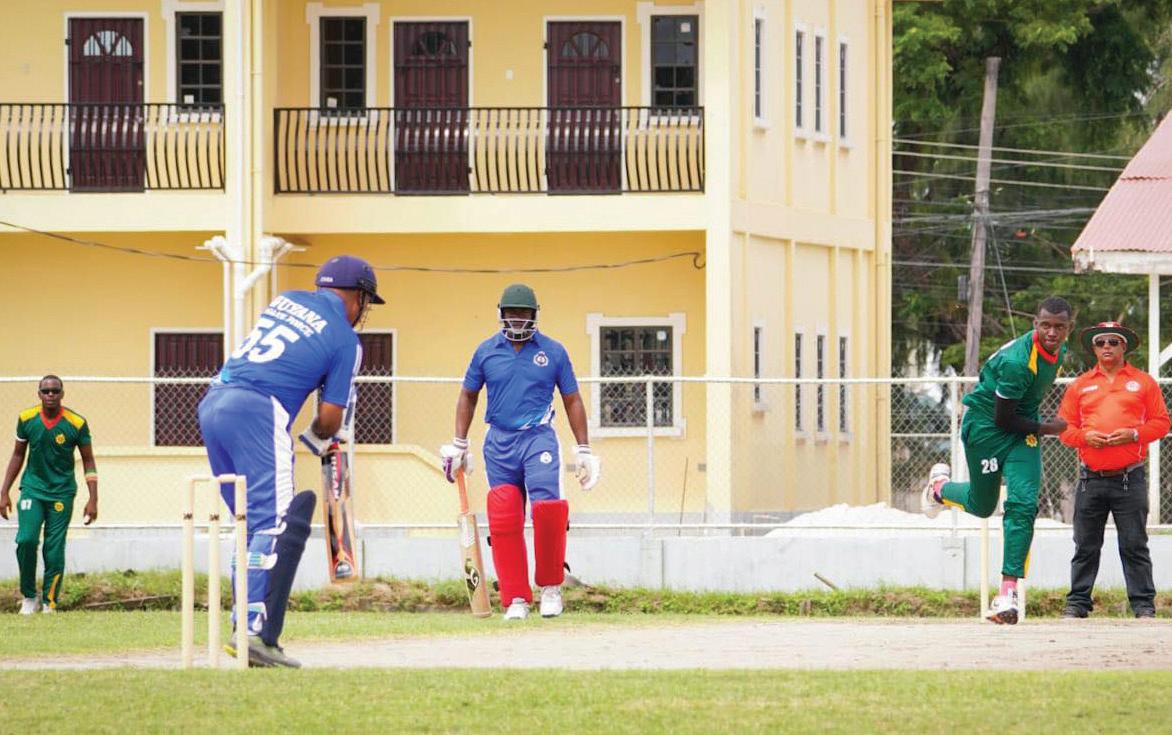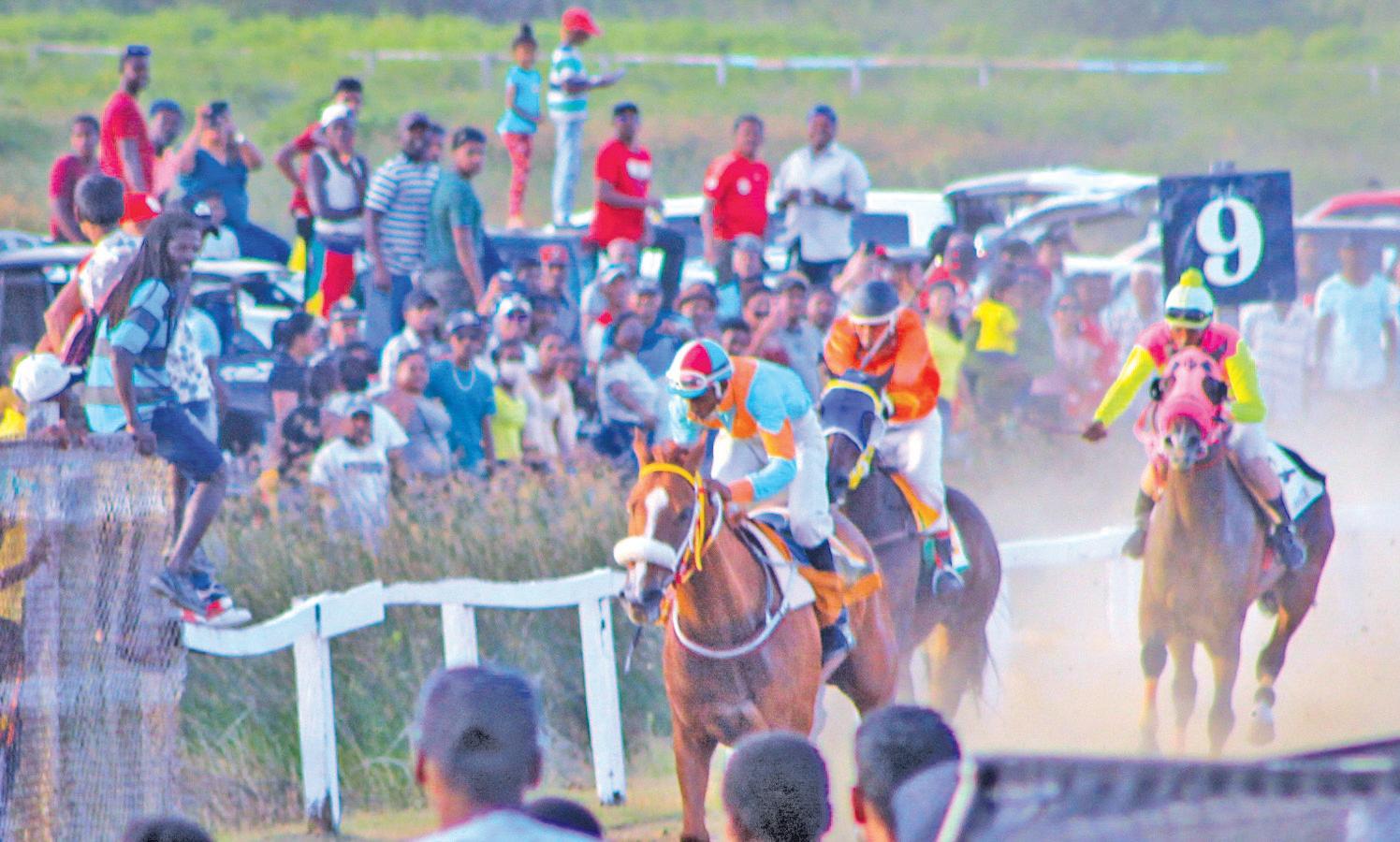


















The Guyana Elections Commission
(GECOM) has des ignated December 12, 2022, as Nomination Day for the upcoming Local Government Elections (LGE), which are set to be held next year March.
GECOM announced the Nomination Day date in a notice that also called for parties to submit their sym bols. On Nomination Day, parties make their way to a designated location, where their representatives are usually required to submit their List of Candidates to the Chief Election Officer, as well as sign on to the re quired documents, such as a code of conduct, to contest the elections.
These representatives are usually accompanied by a large retinue of their supporters, dressed in par ty colours, although all the
parties who submit sym bols do not always make a grand entrance or even come at all.
According to the notice, contesting parties, volun tary groups and individuals must submit their symbols by November 12, 2022, in accordance with section 48 (1) of the Local Authorities (Elections) Act, Cap 28:03. The law requires that these symbols be submit ted at least 21 days before Nomination Day.
“Political parties, vol untary groups and indi viduals in outlying Local Authority Areas (LAAs) may submit their symbol to the Registration Officer at the GECOM Registration Office in their area.”
“A list of candidates submitted by any politi cal party, voluntary group or individual candidate on Nomination Day must be
accompanied by the pre-ap proved symbol, as this is required for the publication of the list,” the notice said.

Under Section 51 of the Local Authority (Election) Act, none can contest the election without submit ting their symbol.
Parties such as the People’s Progressive Party/ Civic (PPP/C), have already signalled their readiness to contest the upcoming LGE.
As far back as August, Vice President Bharrat Jagdeo, who is the General Secretary of the PPP/C, had said that the party is in preparation mode for LGE.
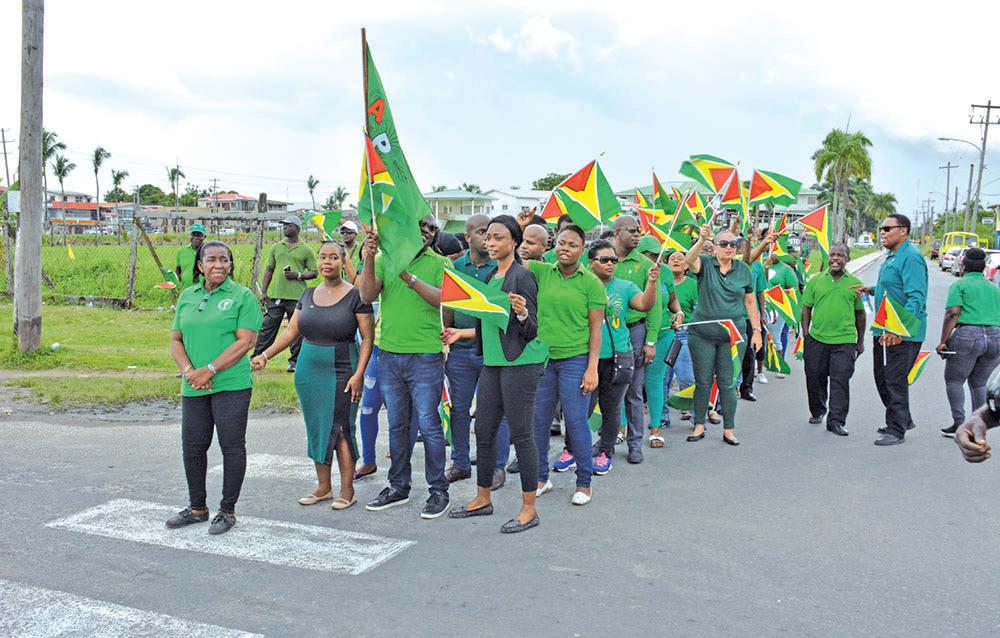

“We’re already gone on an election footing. We’d be ready where elections are held this year or next year.
We don’t control when that happens, GECOM does but we’d be ready at any time,” the Vice President had stated during a press con
ference.
“GECOM would have to write indicating when they are ready. But [in] the People’s Progressive Party, I speak as General Secretary, I’ve already con vened a meeting and we’ve already started working on our organisational struc tures around the country. We’ve put our party in a readiness mode,” he had posited.
But with LGE just months away, there has been much uncertainty re garding the Opposition’s participation in the polls.
Leader of the A Partnership for National Unity/Alliance For Change (APNU/AFC)
Opposition, Aubrey Norton has said that they will not participate in and also threatened to block any elections from being held if the voters’ list is not cleansed.
Since losing the March 2020 elections, the coalition Opposition has been claim ing that the voters’ list is bloated. This is despite GECOM already conduct ing Claims and Objections, a legally mandated method of cleansing the list.
The exercise captured more than 3000 new appli cants who will be eligible to vote by October 31, 2022, with only 18 objections to names on the Preliminary List of Electors (PLE).
And based on a 2019 High Court ruling, GECOM cannot remove any person from the National Register of Registrants (NRR) –from which the voters’ list is compiled – unless they are dead or otherwise dis qualified under Article 159 (2), (3) and (4) of the Constitution.
There is also no confir mation on whether AFC
will seek to contest the LGE alone or in the coa lition. AFC was famously forced to contest the 2018 LGE alone without its coa lition partner and ended up securing just 4 per cent of the total votes cast.
At a press conference over a week ago, AFC Leader Khemraj Ramjattan had told the media that its National Executive Committee will reveal po sition the party’s position on LGE after consultations, slated before 2023.
LGE, which are usu ally due every two years, was last held in 2018. At the last LGE in November 2018, the then PPP/C Opposition had secured 52 of the 80 Local Authority Areas (LAAs). This fol lowed the holding of the LGE in 2016, during which the PPP/C also claimed the majority of the LAAs. (G3)

The Demerara
Monday, Oct 31
Tuesday,
The Berbice
Monday, Oct 31



08:30h



There
Winds:

High
Low
With the Presidential Commission of Inquiry into the events that followed the March 2, 2022 General and Regional Elections set to commence later this week, witnesses are being encour aged to step forward to tes tify.
The Commission is scheduled to commence its hearing on Thursday, November 3, 2022, at Lot 95 Middle Street, Georgetown.
In a notice published in Guyana Times on Sunday and today, the CoI Secretariat said “Any per son wishing to give evi dence on matters relat ing to the Commission’s Terms of Reference may contact the Secretary of the Commission of Inquiry [Javed Shadick]…”

According to Shadick in a recent interview with the Department of Public Information (DPI), persons who wish to give evidence can visit the Middle Street Secretariat in person to give their statements.

He noted that the in formation received will be handled diligently, and the Commission will respond in the shortest possible time to accommodate everyone’s participation.
Moreover, Administrator of the CoI, Colonel Ronald Hercules, also reassured that persons coming forward to testify have no reason to fear since all systems are be ing put in place to ensure a safe process.
He told DPI last Tuesday, that all facilities, accommo dation, and security appara tus are ready, and operating at optimum levels.
“We are totally set and all arrangements are in place to operate a safe en vironment for the inquiry,” Hercules stated.

Fulfilling a commitment made at his inauguration, President Dr Irfaan Ali in June announced the Election CoI and in September, he swore in the members. The Commission will be headed by retired Justice of Appeal Stanley John of Turks and Caicos, who will serve as Chairman, with the pan el also comprising of for mer acting Justice of Appeal in the Eastern Caribbean, Godfrey P Smith, and for mer acting Chancellor of Guyana’s Judiciary, Carl Singh.
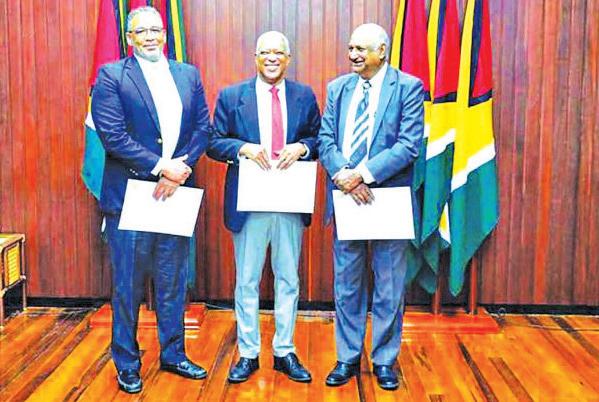
They will be assisted by former Chief Elections Commissioner of India, Dr Nasim Zaidi, and former Chairman of the Ghana Elections Commission, Dr Kwadwo Afari-Gyan, who will serve as resource per sonnel to the CoI.

The Terms of Reference of the Commission include to inquire into and report upon the relevant circum stances and events lead ing up to, and the proce

dures following the March 2, 2020 Regional and General Elections not limited to but including the counting, as certaining and tabulation of votes polled and the public declaration of those results by the Returning Officer of Electoral District No 4 and other election officers.
The Commission will also have to inquire into what at tempts, if any, were made to obstruct, frustrate, sub vert and prevent the count ing ascertainment and tab ulation of votes polled and a declaration of the true re sults of Electoral District No 4 and by whom. They will also have to report on what attempts, if any, were made to obstruct, frustrate, subvert and prevent a deci sion of the Guyana Elections Commission (GECOM), made on March 14, 2020, to conduct a national re count of the votes polled at the March 2 polls from be ing executed and imple mented, and also inquire into the conduct of the Chief Election Officer, other elec tions officers, and others in respect of the discharge and execution of their stat utory duties prescribed by the Representation of the People Act.
Additionally, the CoI is tasked with making such recommendations as the Commission deems fit and necessary to per mit the Guyana Elections Commission to discharge its statutory functions as pre scribed by Sections 84-89,9697 of the Representation of the People Act, Chap 1:03 in a manner which is impar tial, fair and compliant with the Constitution and rele vant legislation and to make any other recommenda tions which the Commission deems appropriate having regard to the law and to any evidence which may be pre sented.
Made public

Already, the People’s Progressive Party/Civic (PPP/C) Government has in dicated that all the spend


ing on the CoI will be made public.
This assurance was giv en by Attorney General and Legal Affairs Minister Anil Nandlall, in re sponse to a request made by APNU/AFC Opposition Member of Parliament Ganesh Mahipaul to the Commissioner of Information for the full disclosure of the renu meration packages of the Commissioners appointed to probe the March 2020 polls.
Mahipaul also sought similar information on the salaries and other benefits of additional persons at tached to the Commission.
But Nandlall said in September that Government would pub lish not only the renumer ation packages, but all the spendings of the CoI.
“…It is going to be an expensive undertaking, and I want to assure that every single cent of the monies that are going to be expended will be made public, because it is pub lic funds. We are going to make it public,” he con tended.
According to the Attorney General, while this will be an expensive
undertaking, this CoI is necessary, especially to bring to light those who were behind the events following the March 2020 polls – something which he argued that the Opposition is afraid of.
Following a large ly smooth polling day on March 2, 2020, Guyana was thrown into a tumul tuous five-month politi cal and electoral impasse after the then incumbent APNU/AFC regime at tempted to steal the elec tion. It was found during a subsequent national re count process that for mer Returning Officer for Region Four (DemeraraMahaica), Clairmont Mingo, had heavily in flated the votes in favour of the coalition party.

Since the election fiasco unfolded, several persons that served within the ap paratus of the Guyana Elections Commission (GECOM) have already been charged with elec toral fraud. These include former Chief Elections Officer (CEO) Keith Lowenfield, former Deputy CEO Roxanne Myers, for mer PNCR Minister Volda Lawrence, and Mingo, among others. (G8)

Editor: Tusika Martin
News Hotline: 231-8063 Editorial: 231-0544, 223-7230, 223-7231, 225-7761
Marketing: 231-8064
Mailing address: Queens Atlantic Investment Estate Industrial Site, Ruimveldt,

Email: news@guyanatimesgy.com, marketing@guyanatimesgy.com

Towards the end of December 2019, four years after its first strike in its Stabroek Field, Exxon announced the start of oil production in our country and three years later, we are producing 360,000 barrels per day (bpd) heading towards one million bpd. With US$1 billion in our Natural Resource Fund (NRF), we are well on our way to being a significant global oil producer. However, rather than preparing Guyanese to participate in the industry and the industrialisation and infrastructural development that were sure to follow, the then A Partnership for National Unity/Alliance For Change (APNU/ AFC) coalition government appeared oblivious of the need to retool our educational institutions. We need to ask what type of education they are supposed to produce for our country.
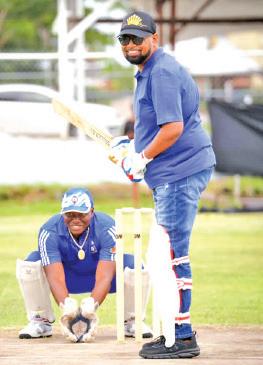

We would then be joining a larger debate and discourse that is ongoing in the developed world. They have been forced into this introspection by their economic collapse since 2008. With no light evident at the end of their tunnel, and facing a crisis in their manufacturing capabilities after decades of depending on China, they realise that much deadwood in the halls of academia will have to be jettisoned. And they are not only questioning just the number of PhDs that are being churned out in obscure fields and even more obscure topics. A hard look is being cast at the relevance of the undergraduate programmes.
The bottom line, the powers-that-be are asserting, is whether the degree awarded is worth the investment which was heavily supported by student loans that have to be now written off. On their own, students have also been asking this question. One of their responses has been to desert programmes in ‘humanities and language’ in droves and head into fields that are directly connected to available jobs such as in the technical and health fields.
In Guyana, the need for this sort of introspection seems to have finally hit both students and administrators. Do we actually need all those graduates in Sociology or International Relations from UG? Are we not just creating trouble for ourselves when the young (and not so young) graduates in those fields cannot find employment? But one development in the US that addresses the need to provide academic knowledge and industry-specific training points in a direction in which we have some experience and which we hopefully can introduce quite quickly: apprenticeships. And since we tend to only copy what is common ‘overseas’, maybe our educators would take notice?
In recent decades, we seem to have bypassed the apprenticeship system, introduced in the sugar industry since the fifties. We’ve opted for some nebulous “internship” system that really do not provide the background and training for its graduates to step into any available jobs. They still need further academic “university” teaching. Apprenticeships, of course, combine paid on-the-job training with collegelevel (Polytechnics) or trade-school classes. The Booker’s Apprenticeship Training Programme (now GuySuCo’s) was immensely successful for decades and can become the model for expanding our apprenticeship schemes. The People’s Progressive Party/Civic (PPP/C) Government has already added an oil and gas component to the Port Mourant apprentice facility, while there has been a privately-funded one opened on the East Coast of Demerara. The Government technical Institutes in all three counties can be adjusted to include apprentices from private companies.
Apprenticeship programmes make economic sense because specific companies – such as the ones now sprouting due to the Local Content requirement for the oil industry and in the now liberalised information and communications technology sector, for instance, should not have to look outside the country to fill their personnel needs. In the US, the Department of Labour is trying to expand apprenticeship models in high-demand fields like health care, green jobs, transportation, and information technology.
Another challenge with the technical institute model that we are expanding would be to offer their graduates the assurance of specific skills that employers need. The apprenticeship scheme, by combining the employers with the institutions and the specific training, removes that doubt. It also allows corporations to more directly absorb the costs of training their employees.
reality of our situation.
If you don’t like shock ploys, the an swer is simple. Join us, become the moderate flank.
Nothing’s worked. More diplomatically put: nothing has yet worked at anything like the pace required. Is it any wonder that desperation is growing?
The closest anything came to working was Extinction Rebellion in April 2019. The radical flank of the environ mental movement punched a hole through complacency and denial and raised climate con sciousness permanently. But it didn’t succeed in its ultimate aim of provoking meaningful climate action from the UK Government.
Governments the world over are simply not taking the findings of climate science se riously. In parallel, the same Governments resist the blunt and terrible truth that the world can no longer stay be low the 1.5C “safe” heating lim it. This year’s United Nations climate summit, starting in a week in Egypt, is extremely un likely to admit this failure. Yet deep down, everyone who pays any attention to the climate de bate knows.
Wouldn’t it be refreshing, therefore, if academics, envi ronmental and business lead ers – even committed politi cians, not to mention activists – were to admit that nothing yet has really worked? I believe the public is waiting for those brave enough to speak these truths and to invite a broad and popular response. But it won’t happen anything like quickly enough if the public continues not to be trusted with the full
This is the tragedy of the moment. Because it is frus trating the full emergence of so much energy and endeavour that will, in my view, become a new moderate flank – one that is all about you: all about where you work or the commu nities where you live, acting collectively in the day to day to turn around the legacy of fail ure outlined above.
By way of example: law yers can express their profes sional agency by choosing what clients and what business they take. The same goes for insur ers who can disclose what they know about the rising threat we face. For academics and teachers, it’s about transform ing what your teaching and re search is about. And for those with access to land, it’s about building resilience and invit ing the community at large, in cluding those who you may not agree with politically, to join in.
It’s about fully facing and sharing the reality of the situ ation and acting on it. This is the opposite of a recipe for do omism. In lieu of anything even remotely resembling adequate plans from our “leaders”, we need to embody an exit strate gy from fossil fuels or else we’ll be ejected into the fossil record.
So it’s clear the next big step forward in climate action must bring the public with us. We need together to step be yond the lures of polarisation, roll our sleeves up and get down to business by identifying (and changing) the underlying reasons for past failures.
My challenge to every read er who doesn’t want to throw soup at anything… join us. Make it so. Make the new mod erate flank a reality. It’s too late to keep ourselves safe, but
not too late to save ourselves from full-scale climate break down.
Dr Rupert Read helped launch Extinction Rebellion. He now co-directs the Moderate Flank Incubator. His most recent book is Why Climate Breakdown Matters
Yes: Half-hearted tactics can’t reach people at a vis ceral level. So let’s up the ante
You’re asking about tactics – which ones work and which ones don’t. First, let me throw a question back to readers: why is this what your newspa per wants you to think about? Why do they want you to pit people taking action against each other? As they’ve pitted me against Rupert Read here? Why do they want you to ob sess over who is right and who is wrong when climate break down looms over us all?
The division is clear – it’s between those who are pre pared to accept the reality of this critical moment in human history and act and those who are not.
Let’s face it: climate break down shatters the deepest bonds that hold us together: our families, our health and our communities.
In Pakistan, 33 million people have had to leave their homes; 146 million people in sub-Saharan Africa can’t get enough to eat. Thousands of lives were lost because of the summer heatwave we experi enced here.
And this is just a tiny hint of the catastrophe coming down the road. Everything about this situation is disruptive.
We can’t wake our world up to this reality without dis rupting daily life ourselves. Blocking roads, throwing soup
and painting luxury shops or ange are nothing compared to the disruption that is already affecting millions of people around the world.
Our Government needs to wake up – and that’s ex actly what disruption brings. It’s an electric shock that calls upon people to see the horror of what’s unfolding before us and to join us in standing up to the evil of the fossil economy to save humanity before it is too late. When we are taking ac tion, we are calling upon people to break through the fear of re pression and to join us in civil resistance.
Moderate tactics can’t reach people at this visceral level. So they can and will be ignored. A million people marched to try to stop the Iraq war in 2003. It did nothing. How many tweets, letters, petitions and march es have there been since we’ve known that oil is killing us?
And the carbon hasn’t stopped rising, the death count hasn’t stopped climbing.
Honestly, answer me this: if our Government is ready to destroy humanity in the race to make oil profits, why would it listen to a tweet?
Historical precedent tells us that in extreme situations only disruption can break through. So we trace our lineage to the suffragettes, to Rosa Parks and the Freedom Riders and to the fight for LGBTQ emancipation. These are our sources of inspi ration – they show us that civil resistance does work.
And to finish, a question for you, Dear Reader. In order to protect your freedoms and your rights and all that you love, will you stand with us? (The Guardian)
Indigo Rumbelow, Just Stop Oil…Is there any point throwing soup at a Van Gogh painting and mashed potato at a Monet? Two activists give their views

Police from the Anna Regina Station District, Essequibo Coast, conduct ed a “White Light Campaign” where a number of vehicles were stopped and examined for co loured lights.
The exercise was conduct ed on Saturday night, along the Anna Regina Public Road be tween 19:00h and 21:30h.
As a result, motor vehicles were stopped and examined for coloured lights by the Divisional Licensing and Certifying Officer.
During the examination, 15 drivers were served with a Notice of Revocation of Fitness and 25 for Prohibition of Tinted Glass.
According to Police, the exer cise is to ensure other road users are not affected whenever they have reason to use the road ways, and to have preventative measures in place for accidents and other incidents.
The Guyana Police Force
(GPF) has started to intensify its campaign against vehicles with coloured lights.

Commander of the East Coast Demerara (ECD) Division, Khali Pareshram had previous ly said vehicles affixed with co loured lights were considered unfit and warned that default ing drivers would be prosecuted.
“We do have special oper ations to target those default ers, especially in the nights across the division. Once they are found culpable, their certif icate of fitness will be revoked,” the Commander had said, not ing that defaulting drivers could face the courts for this offence.
Meanwhile, Commander of East Bank Demerara (EBD), Mahendra Siwnarine had also noted that ranks in his Division were conducting similar opera tions.
“If the vehicles came with those lights…. after a period of time, you go in for fitness…so
once you have (coloured lights), then you will not be given a fit ness and once you are caught on the roadways with those lights, you are arrested and placed be fore the court,” the Commander made clear.
There has been an apparent increase in the number of vehi cles affixed with coloured lights, which pose a danger to other road users. These lights can be blinding and distracting to other road users and can lead to major accidents.
Regulation 34 (1) (a) of the Motor Vehicles and Road Traffic Act, Chapter 51:02 states: “Every motor vehicle, the width of which does not exceed seven feet, other than a two-wheeled motorcycle not having a sidecar attached thereto and an inval id carriage, on any road, during the hours of darkness shall carry two lamps, each showing to the front a white light visible from a reasonable distance.” (G9)
After many months, the peaceful Deepavali celebra tions allowed me a chance to glance at one of the dai ly newspapers in detail.
the bottom of the front page of one of the newspa pers was the headline, "New UN Report warns against gas-to-energy type proj ects". This newspaper arti cle piqued my interest. So I took the time to read the en tire UN Report.
UN Report sought to lecture the Latin American countries on what they should and should not do concerning their energy de velopment plan. But histo ry will prove that this same UN conveniently chose not to steer China, India, Europe, Australia and North America for too many decades away from their cli mate destructive energy de velopment plan. The main stream environmentalists have labelled these plans as the primary cause for the current destruction of the environment.
But I want to focus on my homeland and a signif icant positive development in the making. From all that I have read, Guyana is trying its best to break free from the environmen tally destructive "Bunker C" power generation systems by switching to natural gas.
No nation could achieve first-world status unless it has a low-cost, reliable and uninterrupted power sup ply. And why should Guyana not dream of such a status in my lifetime? The facts will clearly illustrate that our energy network is one of the most expensive and un reliable in the Caribbean.
I want to stand with the ideas put forward by the Hon Vice President Dr Jagdeo, who stated, "there is no path to net-zero with out using natural gas as a transition fuel".
It is economically reck less of any nation to leave natural gas in the ground and move straight to renew able energy at a hefty cost. In support of Dr Jagdeo's suggestions, we must push extremely hard to build the Gas-to-Energy Power Plant before the end of 2024. Any delay will cost this nation billions in lost economic po tential.
Let me outline my case for the man in the street:

1. With modern tech nology, higher-efficient nat ural gas power plants with low methane leakage rates have been proven to produce half the contribution to glob al warming compared to fos sil fuel plants such as those that currently exist at GPL. Thus, there is real and mea surable potential climate benefit in replacing those low-efficiency "Bunker C" gas-guzzling power plants at GPL with higher-efficien cy natural gas plants such as the one designed to be built at Wales. The bottom line is that our Green House Gas (GHG) emissions will be slashed by almost half if we use natural gas at this time at a negligible cost.
2. In pursuit of His Excellency the President’s ambition to expand and build a more resilient and competitive economy by 2030, natural gas is a more sustainable fit into the en ergy mix. The academic pa per by Professor Xiaochun Zhang et al (2014) confirms
that the economic cost im plication to transition the baseload energy of any na tion from coal or base fuels such as Bunker C (as we are using in Guyana) would cost half as much if we move to natural gas as a bridging fuel rather than transition directly to total renewables. And why not when we have almost free natural gas in Guyana in 2022?
3. The facts will reveal that 95 per cent (almost all) of the natural gas from our oil wells is re-injected back into the earth. Would you want that state of affairs to continue with no benefits to the people of Guyana? Or would you prefer some of it to flow to Wales, at a negli gible cost to benefit the peo ple of Guyana directly? The Wales-based Gas-to-Energy Power Plant will produce electricity at approximately five (5) US cents per kWh. When you bolt on GPL's transmission, distribution, and administrative costs, the Guyanese public can benefit from a retail electric ity cost at some fourteen (14) US cents per kWh. Compare that to the current price of electricity in Guyana; thirty (30) US cents per kWh.
4. It is basic econom ics; almost free natural gas, readily available, can leave some 50 per cent of the cur rent light bill in the pockets of every Guyanese electrici ty consumer.

5. The gas pipeline project will be funded as part of the developmental cost of the oil project. Thus, the cash flow implication for the National Treasury is negligible; no loans, no di version of funds from oth er sectors to fund it; and
most importantly, no need to tighten the belts of the working class to support it as was done in 1979 when the workers were told: "Do you want hydro or do you want $14 minimum wages?” They never got the hydro and the $14 minimum wage in 1979. This historical com parison serves as a timely reminder of what a golden opportunity this nation has today in 2022 to build this Gas-to-Energy Power Plant; we must not lose it.
The fact remains that natural gas is the bridge fuel and is not the "be all and end all" of the energy transition strategy of this nation and will not be the only ingredient in our fu ture energy mix. But what is sure at this point in time, is that the low-efficiency "Bunker C" gas-guzzling power plants must go, and the faster this happens, the better for the economic tran sition ambitions of this na tion.
Enough said, but I can not, without a clear con science, remain silent on an economically and scien tifically sound attempt by Dr Jagdeo to provide lower cost and more reliable en ergy to this nation using a "bridge fuel" called natural gas which is in abundance in our jurisdiction. Every patriotic, pro-Guyana, pro gressive Guyanese must stand up and support the Wales-based Gas-to-Shore Power Generation Project. I call on all Guyanese to put all of our energies into com pleting it before 2024.
Sincerely, Sasenarine SinghAfter admit ting guilt to charges for the offences of sim ple larceny, dam ages to property, and threatening be haviour, a Lot 68 Lancaster Unity Mahaica, East Coast Demerara (ECD) fisher man was jailed for 12 months by Magistrate Marissa Mittleholzer last Friday.

Narindra Bajnauth appeared at the Mahaica Magistrate’s Court.
The simple larce ny, property damage, and threatening be haviour charges were
laid contrary to the Summary Jurisdiction (Offences) Act. After he pleaded guilty to the charges, Magistrate Mittleholzer sentenced Bajnauth to a com bined 12 months in prison. (G1)


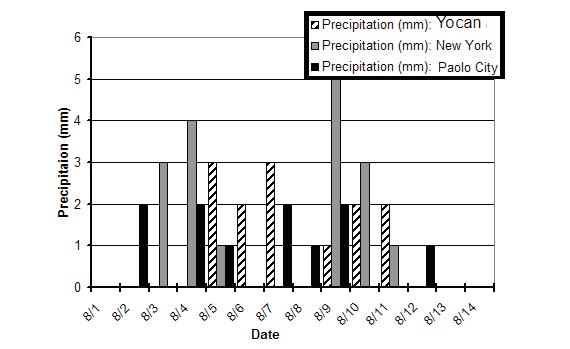
















Awharf and lay down facility that is be ing built in Nismes, Region Three (Essequibo Islands-West Demerara), and will provide crucial sup port to the construction of the Gas-to-Shore Project, is close to being completed and operationalised.

The facility in question is being built by GAICO Construction. GAICO

Managing Director Komal Singh, in a statement on so cial media, noted that they are entering the final stage of the construction of the fa cility which will cost approx imately US$30 million.
“Region Three prepare for massive opportunities! Kudos to His Excellency and to the Government of Guyana. As we prepare for our final stage of construc tion at our Nismes Wharf & Laydown Yard develop
ment,” he said.
Singh also said that key stakeholders from the oil & & gas sector for the Gas-toEnergy Project (GTE) visited the facility on Friday, where they got an update on how
work on the wharf and lay down facility was progress ing.
The facility will primarily be used to support the Gasto-Shore Project. It is expect ed that this will include pro
A family has been left to mourn the loss of their loved one after he was chopped to death at Annai Access Road, North Rupununi, Region Nine (Upper Takutu-Upper Essequibo), while trying to save a driver.
Dead is Aires Matthew.
According to Radesh Phulya, a 48-year-old driv er, on Friday at about 23:00h, he along with Matthew and three other work colleagues were in a white canter parked on the Annai Access Road, con suming alcohol.
While there, Phulya said he was pulled off the canter by two men, one of
whom was armed with a cutlass and who began fir ing chops at him.
Police said that Matthew then tried to intervene to stop the attack but instead, the suspects turned their weapon on him and began attacking him. During the altercation, Mathew was chopped to his right fore arm and chest.
Upon seeing this, his colleagues became scared and ran away. After the at tack, the two suspects also made good their escape in a car.
At about midnight, the friends returned and Matthew and Phulya were placed into a vehicle and es
corted to the Annai Health Centre where Phulya was treated but Matthew was pronounced dead.
The matter was later re ported to the Annai Police Station.
Upon investigating, Police said the informa tion they received was that the attack was a result of Phulya speaking to a fe male teacher earlier in the night at Tractor Bar.
“Efforts are being made to arrest the two suspects. Arrangements are also be ing made to take the body of the deceased to Lethem Regional Hospital's Mortuary,” the Police said. (G9)
viding a storage location for when the 12-inch pipeline that will be used in the proj ect is brought in, as well as construction material and equipment. The completion of the first phase will see a laydown yard, a one-fingerpier and the wharf front at the Nismes foreshore area.
Procurement has al ready been started by the Government of Guyana for the Gas-to-Shore Project. With a timetable to deliver rich gas by the end of 2024 and the Natural Gas Liquids (NGL) plant to be online by 2025, works are progressing on getting the project off the ground. As such, during the first half of this year, Exxon was expected to source the materials and pipeline, so
that they are available for when construction starts lat er this year.
The project will have a 25-year lifespan and is ex pected to employ up to 800 workers during the peak construction stage, as well as some 40 full-time workers during the operations stage, and another 50 workers during the decommissioning stage.
The Gas-to-Shore Project will include a power plant and a NGL plant, all of which will be constructed with in the Wales Development Zone (WDZ). When it comes to the construction of a com bined cycle power plant, this will generate up to 300 megawatts (MW) of power, with a net 250MW delivered into the Guyana Power and Light Grid at a sub-station located on the East Bank of the Demerara River.
The Guyana Government has already invited interest ed parties to make invest ments in the WDZ, which will be heavily industri alised and for which approx imately 150 acres of land have been allocated. Those lands were previously used by the Wales Sugar Estate.
Head of the Gas-toShore Task Force, Winston Brassington has previous ly stated that ExxonMobil Guyana, which is funding the pipeline aspect of the project out of cost oil, has

found that there would be substantial savings from combining these two facili ties.
The scope of the approx imately US$900 million Gas-to-Shore Project also consists of the construction of 225 kilometres of pipe line from the Liza field in the Stabroek Block offshore Guyana, where Exxon and its partners are currently producing oil.
It features approximate ly 220 kilometres of a sub sea pipeline offshore that will run from Liza Destiny and Liza Unity Floating Production Storage and Offloading (FPSO) vessels in the Stabroek Block to the shore. Upon landing on the West Coast Demerara shore, the pipeline would continue for approximate ly 25 kilometres to the NGL plant at Wales, West Bank Demerara.
The pipeline would be 12 inches wide, and is expected to transport per day some 50 million standard cubic feet (mscfpd) of dry gas to the NGL plant, but it has the ca pacity to push as much as 120 mscfpd.
The pipeline’s route on shore would follow the same path as the fibre optic ca bles, and will terminate at Hermitage, part of the WDZ which will house the Gas-toShore Project. (G3)
…Nismes wharf & laydown facility will provide massive opportunities – GAICO
Swift response by the Guyana Police Force (GPF) led to the re covery of a motor vehi cle that was hijacked from East Street, Georgetown, on Sunday.

While details on the hi jacking remain sketchy, Guyana Times was in formed that a purple 212 motor car, with licence plate number PMM 8381 was stolen around 03:30h on Sunday.
Shortly after the car was stolen, it was posted on social media and the Police were informed and imme diately went in search of the vehicle.
Persons were also seen on Facebook, tracking the vehicle and informing the owners of when it had passed their homes.
The last post on social media stated that the car was spotted passing the vil lage of Supply, on the East
Bank of Demerara, with a changed number plate. This was around 16:00h.
Sometime later, the ranks of the Guyana Police Force managed to recov er the vehicle that was abandoned at the D’Urban Backlands, Georgetown
area. It is still unclear if anyone was arrested in re lation to the carjacking.
This is the second car jacking incident that has occurred in a matter of two days. On Friday, an Allion motor car bearing regis tration number PSS 1403
was stolen between 01:00 and 03:00h at Mahaicony, ECD.
The car was last seen at Red Road, Sophia, Greater Georgetown, on Friday evening after the owner alerted persons that the car was stolen. (G9)
Well, maybe by the time you read this, you know who’s the President of our giant southern neighbour, Brazil. As your Eyewitness pecks away with his two fingers, the voting’s just begun. You’d remember there was an election at the beginning of this very month. But under their rules, since no contestant received more than 50 per cent of the votes, they have to redo it all over again!! So, we had a first round and now we’ll have a second round and go on until someone gets more than that 50 per cent!!
Two general elections in one month in a country where voting’s compulsory and there are ONE HUNDRED AND FIFTY-SIX MILLION voters!! The last turnout was 123 million or 79%. The two candidates were Lula - who received 57 million or 48 per cent and the incumbent Bolsonaro – who snagged 51 million amounting to 43 per cent. In case you wondered about the missing 9 per cent, that was divvied up among a number of fringe candidates.
Now - as you should know by now – whenever your Eyewitness discusses these foreign goings on, his focus is how does it affect little ole us! And even though in this globalised world, we’re all connected – think of the Ukraine War and your foodstuff prices! – with Brazil, the connection is literal! All in all, it really hasn’t mattered who rules Brazil up to now. Unlike Venezuela and Suriname, they haven’t cast any covetous eyes on our territory. In fact, since they always resented Venezuelan pretentions for the leadership of Latin America, they always acted as a counterfoil to their aggression against us.
But you can never take these things for granted, can you?? Look how communist Chávez’s election in Venezuela turned out for us…6 million refugees into neighbouring countries and counting!! Thank God for all those jungles between their populated centres and us –our refugee count is probably about 50 thousand. Which is still comparatively substantial. But back to Brazil…from where our development will attract some of their citizens looking to share in our oil-fuelled action.
Unlike our two political parties that have gravitated towards neo-liberal policies while reflexively insisting they’re for the “working class”, in Brazil the old Cold War ideological divide is alive and kicking. Bolsonaro has put his right-wing money where his mouth is and favours all the conservative nostrums – low taxes, bigger military, to heck with environmental hug-a-tree initiatives. And the leftist Lula automatically takes the opposite stance!! In Brazil, they know what policies they’re voting for!!
In the first run-off, most folks thought Lula was a shoo-in – with polls agreeing – but Bolsonaro closed the gap and here we are with the polls showing Lula leading, but Bolsonaro closing in again.
But Lula’s gonna win it by a whisker!!
Your Eyewitness was gobsmacked – yes mate, “gobsmacked”! – to read that ANSA McAL was allowed to announce they’ve purchased 82 acres of land at Wales and will be constructing “a wharf and laydown yard”!! Now, a “laydown yard” – your Eyewitness discovered after hitting his Google search button – “is an area on a construction site where tools, materials, equipment, and vehicles are stored temporarily when they are not in use. Laydown areas are most common on construction sites, but other industries like manufacturing or oil field operations use them as well.”

And yes, Dear Reader, that “oil field operations” clause stuck out like a very sore thumb!! In your Eyewitness’s mind there’s absolutely no doubt ANSA’s planning to service the Oil Industry. So, what about our “LOCAL CONTENT LAW”?? Forget all the patter from the ANSA execs about loving Guyana and all that – aren’t Guyanese following that OP fella explaining that Businesses are only interested in their PROFITS??

So, will ANSA take on a LOCAL PARTNER??

Your Eyewitness notes that Cricket West Indies deigned to select a solitary Guyanese – young Chanderpaul –for the upcoming series Down Under. The young man –inevitably, even though unfairly – has some pretty large boots to fill. Good luck!!
Guyana is expected to produce a net figure of 110,000 barrels of oil per day in the fourth quarter of the year, continu ing the upward trend of oil production that will also re sult in nine cargoes of crude oil being sold in that period.
This is according to Hess Corporation in its 2022 third quarter report. In it, Hess reported that net produc tion from the Liza Destiny and Liza Unity Floating Production Storage and Offloading (FPSOs) vessels was 98,000 barrels of oil per day in the third quarter of 2022. Just last year, this figure was 32,000 barrels per day.
According to Hess, net production on a quarterly basis will just continue to rise, with the fourth quar ter (or the last three months of the year) expected to reg ister 110,000 barrels of oil per day in net production.
“Net production from Guyana in the third quar ter of 2022 included 7000 bopd of tax barrels. There were no tax barrels in the third quarter of 2021. The Liza Unity FPSO, which commenced production in February 2022, reached its production capacity of 220,000 gross bopd in July 2022.”
“Guyana net production
is forecast to be approx imately 110,000 bopd in the fourth quarter, which includes approximate ly 20,000 bopd of tax bar rels. For the full year 2022, Guyana net production is forecast to be approximate ly 77,000 bopd, which in cludes approximately 7000 bopd of tax barrels.”
When it comes to oil sold, Hess revealed that in the third quarter, they sold eight cargos of crude oil from Guyana compared with three cargos in the prior-year quarter. In the fourth quarter of 2022, they further expect to sell nine cargos of crude oil.

The oil rich Stabroek Block is 6.6 million acres (26,800 square kilome
tres). Oil giant ExxonMobil, through subsidiary Esso Exploration and Production Guyana Limited (EEPGL), is the operator and holds 45 per cent interest in the block. Hess Guyana Exploration Ltd holds 30 per cent interest, and CNOOC Petroleum Guyana Limited, a wholly-owned subsidiary of CNOOC Limited, holds the remaining 25 per cent interest.
It is understood that the joint-venturers have so far invested over G$3 tril lion in the block and that their exploration and pro duction plans up to 2025 would likely increase their
investments to more than G$6 trillion. Exxon’s to tal investments in Guyana, meanwhile, amount to ap proximately G$1.3 trillion on its own.
Exxon, as operator in the Stabroek Block, is now responsible for 35 out of the 40 oil finds made in Guyana’s waters since 2015. In July of this year, it had announced oil finds at its Seabob-1 and KiruKiru-1 wells.
The Seabob-1 well, drilled by the Stena Carron ship at a depth of 4660 feet, encountered 131 feet of oil. On the other hand, the Kiru-Kiru-1 well, drilled by
the Stena DrillMAX at a depth of 5760 feet, encoun tered 98 feet of oil.
In April of this year, Exxon had also announced three oil finds in the Stabroek Block. The three discoveries were southeast of the Liza and Payara de velopments and at the time had brought the tal ly of discoveries made by ExxonMobil in Guyana in 2022 to five. The Lukanani well was spud and com pleted by the Noble Tom Madden, while Barreleye was drilled by the Stena DrillMAX and Patwa by Noble Don Taylor
The first two sanctioned
offshore Guyana projects for the joint venturers, Liza Phase 1 and Liza Phase 2, have so far achieved an av erage of nearly 360,000 bar rels of oil per day in the third quarter of this year.
A third project, Payara, is expected to start-up by the end of 2023, and a fourth project, Yellowtail, is expected to start-up in 2025. The partners are cur rently pursuing environ mental authorisation for a fifth project, Uaru. By the end of the decade, it is ex pected that Guyana’s oil production capacity will be more than one million bar rels of oil a day. (G3)
Asearch exercise con ducted by ranks of the Guyana Police Force and the Guyana Prison Service (GPS) re sulted in the discovery of a number of contraband items at the Lusignan Prison, East Coast of Demerara (ECD).
The exercise was car ried out between 06:15h to 08:50h on Saturday.
According to Police, the search led to the discov ery of 20 cell phones; 23 improvised weapons; one
flash drive; 10 chargers; six phone batteries; two pairs of scissors; 23 lighters; a metal spoon; two knives, a file; three packs of tobac co paper, and 122 grams of cannabis.
Two weeks ago, a num ber of prohibited items, in cluding cellular phones, were found during a rou tine search at the New Amsterdam penitentiary.
It was reported that the exercise was carried out by prison officials with the as sistance of ranks from the
Guyana Defence Force, and other ranks of Police Regional Division No 6.
The contraband items found during that opera tion included two zip lock bags containing ganja, 17 improvised weapons, 23 lighters, a number of razor blades, three pairs of scis sors, and 11 cell phones.
The items were taken to Central Police Station where they were lodged, to be disposed of.
Three weeks before that, a joint search exer
cise conducted at the New Amsterdam Prison un earthed a number of ille gal items including two Samsung and one ZTE cel lular phones; four phone batteries; 60 zip lock bags with a number of leaves, seeds, and stems suspected to be cannabis amounting to 37.9 grams; one Digicel SIM card; 37 lighters; four phone chargers; 18 ra zor blades; 10 improvised weapons, and two pairs of scissors. (G9)

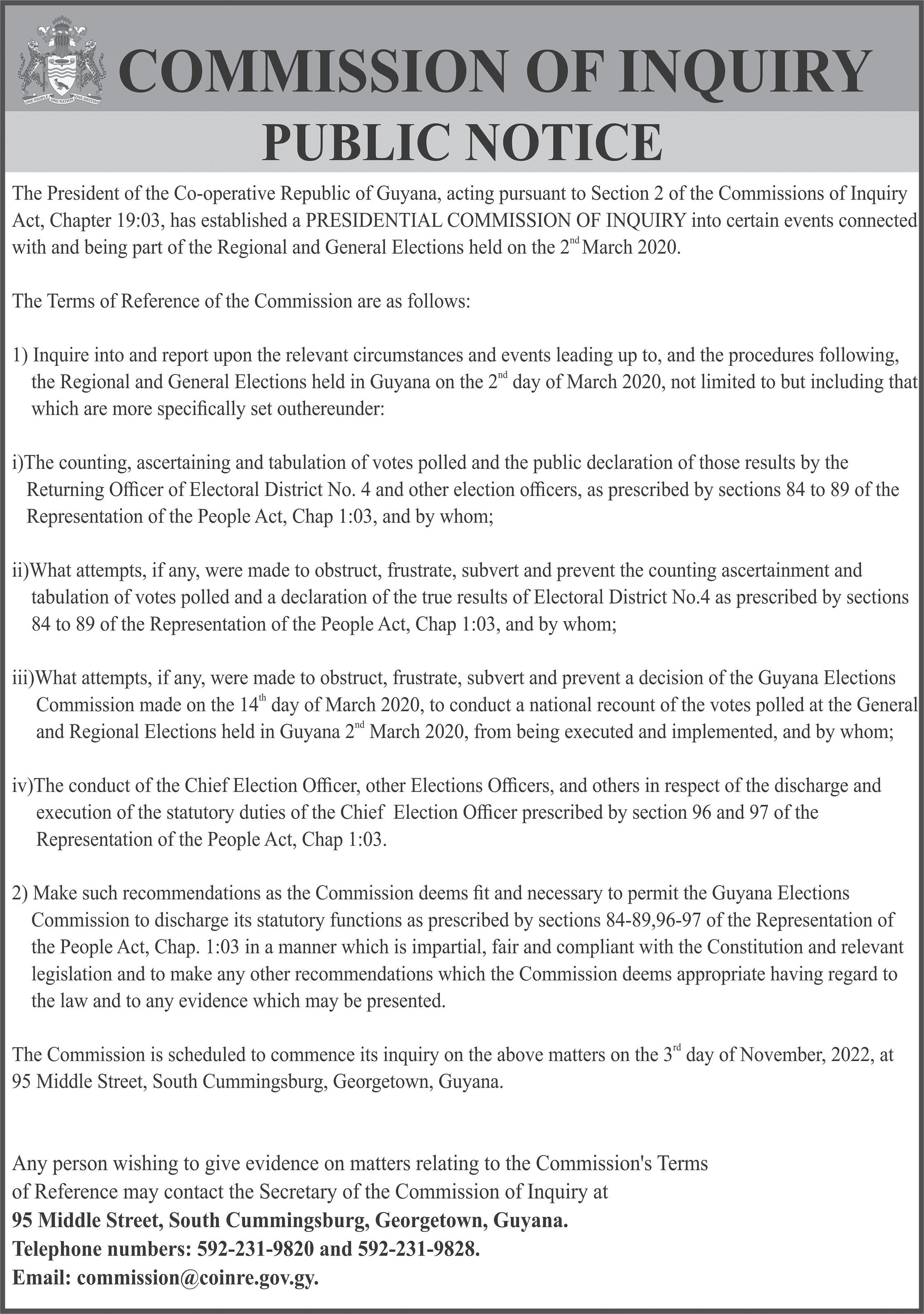
Attorney General Anil Nandlall, SC, has praised Guyana’s court of last resort, the Caribbean Court of Justice (CCJ) for what he described as “highly commendable” rulings in matters, in par ticular, those of a high con stitutional nature and on politically tense issues.

He made the comment last Thursday while ad dressing a law seminar or ganised by the University of the West Indies (UWI) Cave Hill Campus, Law Faculty, to discuss rulings by the Caribbean’s two apex courts, namely the Trinidad-based CCJ and the UK’s Privy Council.
The meeting was entitled: Privy Council (Chandler) v CCJ (Nervais): The “Savings Law Clause” and Caribbean Constitutional Interpretation. It saw the presenters sharing their views on these two fun damentally different ap proaches to the interpreta tion of the savings clause in Commonwealth Caribbean constitutions by the two apex courts.
The Privy Council did not agree with the reason ing of the CCJ in a trilogy of decisions, namely, Nervais v R, a case from Barbados; and McEwan v Attorney General of Guyana and Marcus Bisram v Director of Public Prosecutions, both cases from Guyana.
Savings law clause is a common feature of the Constitutions of former British colonies, including Guyana, which was includ ed at independence to pro vide continuity of the law
during a transitionary peri od. It is found in Article 152 of Guyana’s Constitution.
According to Nandlall, the fundamentally differ ent approaches to the inter pretation of the savings law clause taken by the courts in these matters have to do with several factors, includ ing interpretation, jurispru dential rationale, and phi losophy.
“Both the CCJ and the Privy Council have arrived at highly tenable, highly at tractive, and highly com mendable positions. It’s a question of philosophy, jurisprudence, and how one sees oneself as a final court,” Nandlall told the panel of regional legal minds.
“As I said, one is dis tant,” the Attorney said as he referred to the Privy Council’s location.
He labelled the CCJ as being indigenous and a product of the environment. These, he noted, are the in nate and intrinsic factors that are informing the dif ference in “outlook and out
put”, in other words, the rulings being rendered by the courts.
With Guyana abolishing the Privy Council in 1973, it did not have a final court of appeal outside of the coun try until 2005 when the CCJ was inaugurated. Nandlall believes that the addition of the CCJ to the country’s judicial structure has been revolutionary.

He pointed out, “The benefits that Guyanese have derived already from the CCJ are certainly im measurable in particular when it comes to very im portant, highly tense polit ical issues. Outside of that, in land law, in particular, we’ve had a great amount of equivocation, ambiguity, and confusion on the area of land law in particular Roman Dutch law. Those is sues were completely clari fied by the CCJ in a series of decisions.”
When it comes to com mercial litigation, the

Senior Counsel stated that the CCJ has provided great clarity on several issues in its pronouncements. In constitutional matters and matters related to election laws, the CCJ has clarified very crucial and highly con tentious issues, said the Attorney General. He not ed, “It [the CCJ] has been a great blessing for Guyana and the people of Guyana.”
Besides Nandlall, the other members of the pan el were Senior Counsel Douglas Mendes, a for mer Judge in Trinidad and Tobago; King’s Counsel Dr Francis Alexis, a for mer Attorney General of Grenada; Dr Lloyd Barnett, Chairman of the General Legal Council and the Independent Jamaica Council for Human Rights; and Professor Eddy Ventose, Dean of Law at UWI Cave Hill Campus.
Apart from Guyana, in its Appellate Jurisdiction, the CCJ is also the final court of appeal for crimi nal and civil matters for Barbados, Belize, and Dominica. All the oth er Caribbean Community (Caricom) member states have retained the Privy Council.
Meanwhile, in its Original Jurisdiction, the CCJ is an internation al court with exclusive ju risdiction to interpret and apply the rules set out in the Revised Treaty of Chaguaramas (RTC) and to decide disputes aris ing under it. The RTC es tablished Caricom and the Caricom Single Market and Economy (CSME).
In its Original Jurisdiction, the region al court is critical to the CSME and all 12 member states which belong to the
CSME (including their cit izens, businesses, and gov ernments) can access the court to protect their rights under the RTC. (G1)
TheDemerara Habour Bridge Corporation (DHBC) has filed an over-a-billion-dollar law suit against the vessel—MT Tradewind Passion—which collided with the floating structure on October 8, ren dering it inoperable for just over two days and resulted in a $1 billion repair bill.
The vessel is owned by Canama Trading S De RL, a company registered in Panama.
In its Statement of Claim (SoC) filed at the Demerara High Court, the DHBC said that the collision caused $1 billion and counting in dam ages and that there has been no compensation despite sev eral oral requests demand ing payment of the sum.
As such, the corporation is seeking $50 million in
damages for negligence since the master of the vessel was negligent by not exercising the relevant international safety conventions for safe ty at sea. It said that the master did not apply the ap plicable speed necessary in the prevailing circumstanc es. Due to the negligence of the master and the vessel’s crew, the DHBC complained that it has suffered and will continue to suffer extensive losses.
According to the DHBC, the vessel’s master was neg ligent since he failed to sail at a safe speed; failed to re port difficulties being en countered upon approach ing the bridge; and failed to use reasonable care and skill in its operation so that the
fuel tanker could veer away from, thereby avoiding colli sion with the bridge. At the time, the vessel was under the control and command of Captain Freddy Mendoza, advised by Pilot Kenneth Cort, who a Board of Inquiry (BoI) into the collision has recommended be suspended for not less than 24 months.
Apart from damages for negligence, the DHBC is fur ther seeking special dam ages of $1 billion; inter est under the Law Reform (Miscellaneous) Provisions Act; such further or other or der or relief the court deems
just; as well as costs.
Collision
Reports indicate that at around 02:00h on October 8, the vessel which trans ports fuel for the Guyana Oil Company (GuyOil), while heading south, crashed into the Demerara Habour Bridge, despite desperate calls to ‘drop anchor’ from the Shift Supervisor Andy Duke.
Duke, who was in one of the lookout towers, tried desperately to communicate with the pilot without suc cess. He eventually had to jump from the booth to save his own life. He fractured his leg in the process and was hospitalised. The other men who were working at the bot tom of the bridge, including Mechanical Maintenance Engineer Ahmad Khan, had to run for their lives.
General Manager, Wayne Watson, in an affidavit, de posed that he believes it will be removed from Guyana before the lawsuit is deter mined.
But Canama Trading S De RL contended that the detention of the vessel, without an application pur suant to Section 439 (1) of Guyana’s Shipping Act be ing made to the court, consti tutes a wrongful and unlaw ful deprivation, detention, interference with, trespass upon, restraint, or imprison ment of its property and the crew of the vessel. An appli
diction and therefore wants it to be released immediate ly. It said that the DHBC has refused to accept full and valuable security it has of fered and continues to offer.
The company is claiming loss of use of the vessel at a daily rate of US$12,250.

Canama Trading S De RL has also made an urgent ap plication to the High Court to argue limitation of liabili ty pursuant to Section 402 of Guyana’s Shipping Act as a defence to the DHBC’s law suit.
In its particulars of spe cial damages, the DHBC, among other things, listed the cost for anchorage parts including buoys, sheaves, anchor chains, shackles, and wire rope.
Also included was the cost of structural compo nents parts including con necting posts, junction pins, panels, sway braces, sway brace bolts and nuts, and deck plates. It is also claim ing money for toll revenue loss from October 8 to 10, labour, and meals and re freshments for workers. The DHBC is also suing for pro jected works it will have to carry out on the bridge.

The claim was filed by PPP/C parliamentarian, Attorney-at-Law Sanjeev Datadin.
‘Wrongful detention’
The vessel has been detained as the DHBC’s
cation has since been made to the High Court for a war rant of arrest to be issued against the ship.
Canama Trading S De RL argued that the deten tion of the vessel is unlawful as it was done without or in excess of jurisdiction, with out reasonable grounds, and not in compliance with stat utes and the Constitution of Guyana. As such, it is suing the Maritime Administration Department (MARAD), Harbour Master Glasford Archer, and the DHBC for more than $100,000.
The company said that the vessel is under charter to GuyOil, operating between Trinidad and Guyana, and remains under the instruc tion of GuyOil for at least an other year. Considering this, it argued that there were no reasonable grounds for con cluding that the vessel would imminently depart the juris
In that application, it is seeking an order that it be entitled to constitute a lim itation fund under Section 414 (1) of the Shipping Act by paying or lodging with the court, as securi ty, $244,944,006.21 plus in terest thereon at the rate of four per cent per annum from October 8 to the date of the constitution of the fund. According to the company, it reserves all rights to con test any sums claimed by the DHBC, whether on grounds of failure to mitigate, or oth erwise.
The collision caused ex tensive damage to critical components of the Demerara Harbour Bridge, which not only left it inoperable but re sulted in thousands of pas sengers and tons of agricul tural produce stranded on both sides of the Demerara River.


While repairs were be ing carried out on the bridge which was reopened on October 10, water taxis which normally operate for 12 hours, were allowed to work for 24 hours. Given the psychological impact the col lision has had on the bridge’s staff who were on duty at the time, with some of them still heavily traumatised, the BoI said that clinical interven tions may be needed. (G1)


in the awareness walk.
In an effort to raise aware ness of Rett Syndrome –a neurological genetic disorder – Precious Angels, a non-profit organisation on Sunday hosted its 4th an nual awareness walk which saw scores of people from all walks of life participating.
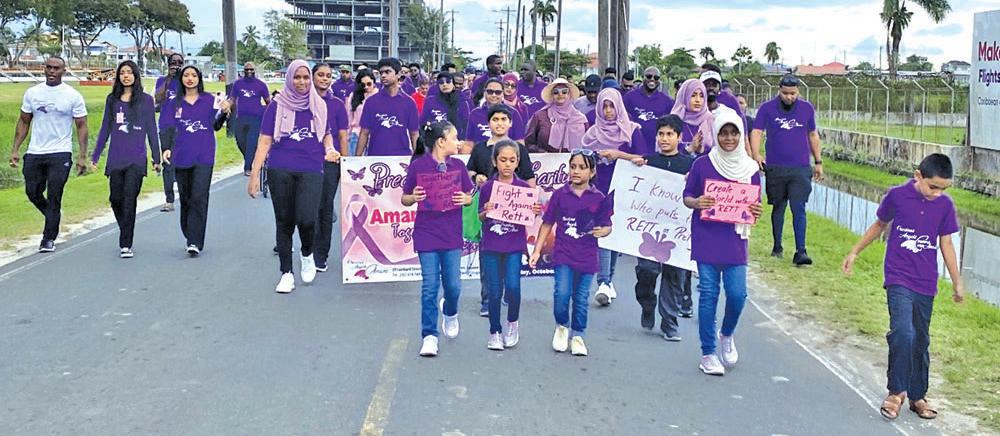

The walk started at the Muslim Youth Organisation (MYO) Ground and made its way to Lamaha Street then onto Vlissengen Road and into Thomas Lands and back to the starting point for a brief programme.
During the programme, Dr Mallika Mootoo, a pri vate paediatrician, stated that children who were diag nosed with Rett Syndrome need a lot of support.
“There is no cure for Rett Syndrome but there is a lot of research that is going on at the moment. The future, however, does look hopeful for Rett but in the mean time what we do is support the children by giving them systematic support… if they have problems with speech,
they will need speech ther apy, if they have problems with their balance, they need psychotherapy, occu pational therapy and just trying to engage the family and the people in this field to help the children with Rett.”
She further stated that it is their goal to enable each child who was diagnosed with the disease to live to their fullest potential.
In addition, she noted that due to the many symp toms associated with the disease, it tends to overlap other illnesses.
“Many times, children are diagnosed late with Rett Syndrome. One of the things we are trying to do here is to raise awareness of Rett Syndrome so that if people see certain symptoms, it may be Rett and may not be
only autism.”
Dr Mootoo stated that the disease affects almost every system in the body, leading to seizures, loss of speech, loss of motor skills, diminished eye contact, breathing problems, wring ing and washing of the hands, and scoliosis.
However, the young est daughter of business man and philanthropist, Azruddin Mohamed is the first case of Rett Syndrome in Guyana. Amani’s sis ter, Arya Mohamed, ex plained that this is the 4th Awareness Walk that was organised to educate par ents about the symptoms of the disease.

She nevertheless thanked those who took time out from their busy Sunday to join her family and more so Precious Angels
We really want to say thank you to all who have come out to walk with us… we appreciate your support that is being shown toward children who suffer from Rett Syndrome,” the young Mohamed added.
Meanwhile, Sharmaine Ranjee, the therapist who takes care of Amani, ex plained that is always fun to attend to her, adding that she is unique in her own way and she is blessed –
blessed to be in the family she is in because she is be ing provided with the most optimal care that a child with Rett Syndrome would need.
She too stated that chil dren with this disorder have to be treated and supported to the fullest and more im portantly, feel included.
Presently, there are about five occupational therapists, six speech ther apists along with trained rehab practitioners to assist

children with such diseas es. These services are also accessible throughout the country.
Statistics have shown that one billion people worldwide experience some form of disability. Rett Syndrome affects about 1 in 10,000 girls, but is hardly found in boys.
Doctors can easily di agnose Rett by observing signs and symptoms at ev ery stage of growth and de velopment.
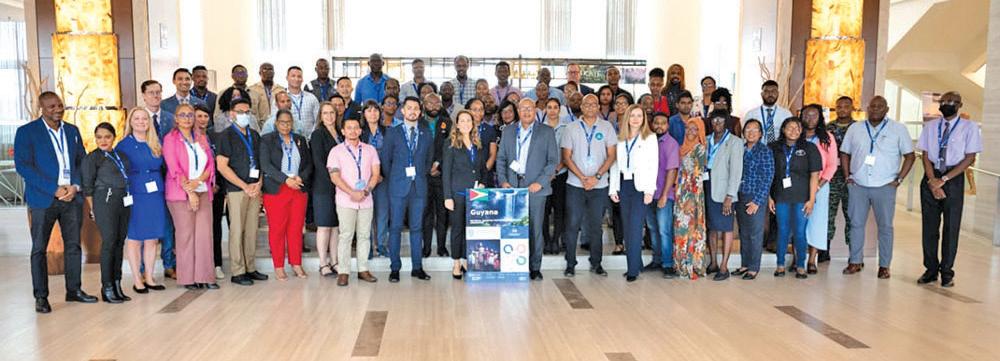
over a number of months.
The United States Southern Command and the Guyana Civil Defence Commission (CDC) last week complet ed a National Disaster Preparedness workshop, bringing the curtains down on a baseline assessment of Guyana’s disaster risk and readiness.

The workshop was con ducted by the Pacific Disaster Center (PDC), a University of Hawaii research centre that is a specialised Disaster Risk Management (DRM) organisation. In addition to the CDC, other DRM stake holders also participated in the workshop held last Wednesday at the Marriott Hotel in Georgetown.
The workshop culminat ed in a National Disaster Preparedness Baseline Assessment (NDPBA) which was carried out in Guyana
Using a collaborative, stakeholder-driven ap proach, PDC’s National Disaster Preparedness Baseline Assessment uti lises scientific data and evidence-based practic es, integrating the nation al priorities of Guyana with stakeholder feedback to effectively reduce disaster risks.
The discussions on key risk reduction recommen dations and procedures emanating from the base line assessment will serve to improve Guyana’s pre paredness and response ca pabilities in the event of a di saster and aid planning for future climate-driven disas ter impacts.
Data from a myri ad of agencies such as the Health Ministry and the Environmental Protection
Agency (EPA) was collect ed in order to produce find ings on risk and vulnerabil ity, and exposure and coping capabilities when manag ing hazards and disasters in Guyana.
Director of Global Operations, Dr Erin Hughey said that such an undertak ing by the CDC to utilise her entity’s expertise was both innovative and necessary.
Dr Hughey indicated that PDC has years of global ex perience that can enhance Guyana’s capacity to prepare for, manage and respond to various hazards and disas ters. She also said that she was very impressed with the strides made locally to alle viate many issues revolving around DRM but acknowl edged that we as a nation have a far way to go.
Meanwhile, Director General of the CDC, Col
(Ret’d) Nazrul Hussain lamented on the importance of such programmes, partic ularly when all DRM stake holders are involved. He went on to say that hazard management is a collective effort “and we must all learn from the actions of the past if we are to make consistent progress.”
Col (Ret’d) Hussain also expressed gratitude to PDC for the NDPBA and assured the participants that the Government of Guyana will appreciate the guidance of fered in the findings.
PDC, whose base of op erations is in Hawaii, also
provided those in atten dance with a glimpse of their DisasterAware application. This app is poised to monitor and report in real-time any hazards that may face a par ticular area for a specific pe riod of time. They explained that the DisasterAware plat form was precisely designed for Disaster Risk Managers so that effective prepared ness, response and mitiga tion can be achieved and maintained.
Training opportunities were also showcased by the American organisation so that local agencies can build capacity for the future. A re

port compiled by PDC is ex pected to be presented soon to the CDC which will out line the strengths and weak points in Guyana’s DRM.
These activities are part of continued US support to Guyana in the areas of ener gy governance, regional secu rity, and enhanced disaster response capabilities.
This partnership between Guyana and the US aug ments an already strong bi lateral cooperation on disas ter response between the two countries and sets the stage for the regional Tradewinds exercise scheduled for July 2023. (G8)

The Agriculture and Local Government
Ministries will be col laborating on the establish ment of a ranger squad that will operate in areas where rice is grown in close proxim ity to where animals are being reared.
This agreement was met on Saturday between Agriculture Minister Zulfikar Mustapha and Local Government and Regional Development Minister Nigel Dharamlall when they met with rice farm ers on the Corentyne.

Rice and animal farmers in the 52/74 Neighbourhood Democratic Council (NDC) have been at loggerheads over cattle damaging rice and the impounding of the animals.
Following the 2020 floods, the Agriculture Ministry had put systems in place to save animals that were dying in flood waters in the savannahs. The savannahs were flood ed with water from the Canje
them.
Quoting the law, one cattle farmer, Krissondat Persaud, said if animals go into your field, a person can impound it themselves or get persons to do it.

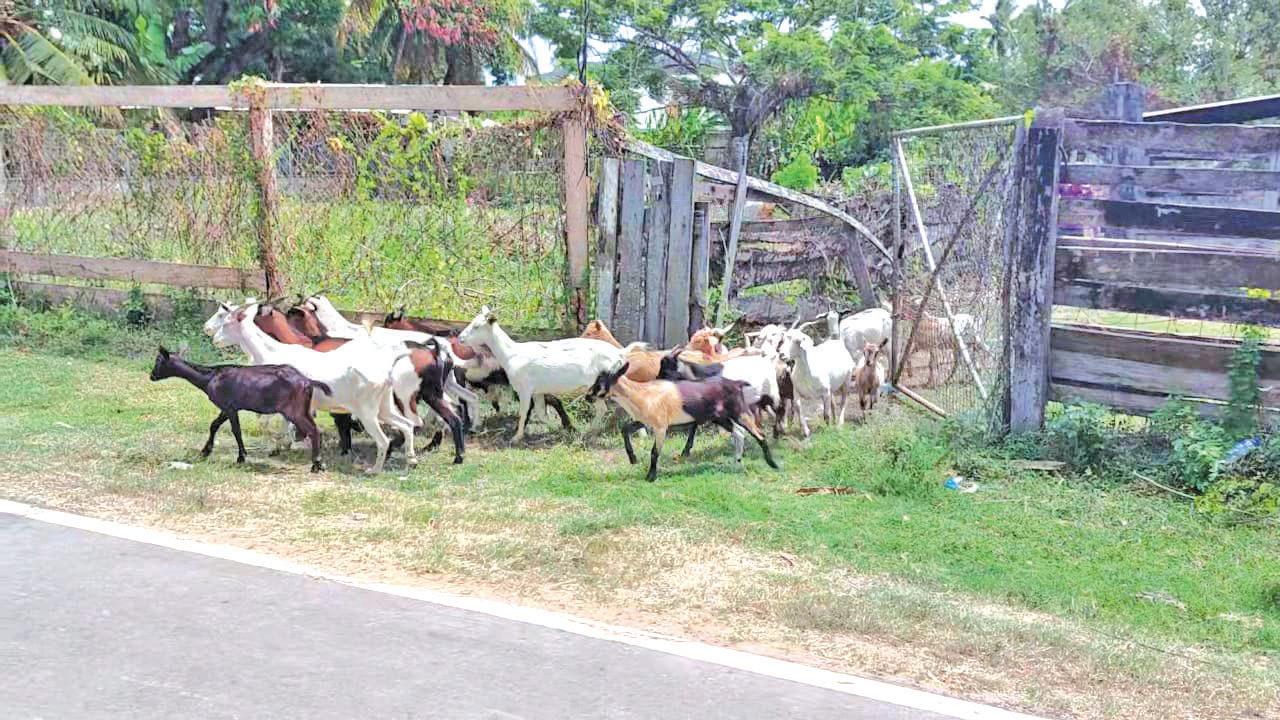
Another rice farmer at
tivates rice nearest to the sa vannah and every day cattle go into his rice fields and dam age his crop.
Noting that Government assisted with $14 million to construct a fence to keep the animals in the pasture, he said the animals still find themselves in the rice fields.
Government had spent the money to fence 17,000 acres of savannah land for cattle and small ruminants.
The rice farmers claimed that the animal farmers have cut the fence and are deliber ately letting the animals out.
Act responsibly
However, Minister Mustapha noted that it is an age-old problem in the NDC area. He said this problem does not exist in other commu nities even though cattle and rice are there.
“In Region Five [MahaicaBerbice] we are not getting this issue so there is some problem in this area and we have to look and see what is causing it. I know for a fact that there are many irrespon sible cattle farmers who are loosing their cattle without care and the cattle is entering people’s fields. But at the same time, there are a lot of person ality issues too in 52/74.”
Inter-Ministry effort
Meanwhile, Local Government Minister Nigel Dharamlall said that the Ministry will be providing 12 persons as part of an in ter-Ministry collaborative ef fort.
“Those persons will be re sponsible for patrolling and going around the backdam because the problem is that there are accusations that when you have these stray catchers they have been im pounding people’s animals when they are not in the culti vation,” Mustapha added.
“The attorney will come out with an opinion because all of the pounds fall under the Pound Act. He told me
that by Tuesday he will give an opinion and from there we will move the process,” the Agriculture Minister in formed.
The Agriculture Minister pointed out that a zoning sys tem will have to be imple mented and farmers will have to comply and only have ani mals in areas zoned for ani mal rearing and rice and other crops in their respective zones.
The meeting was held at New Market Primary situated at Number 63 Village.
Meanwhile, during the meeting with animal own ers which was held at Tagore Memorial Secondary, also sit uated at Number 63 Village, both Ministers called on the
farmers to work collaborative ly to address the problem.
However, the Agriculture Minister warned them to keep their animals from persons’ cultivation.
“If you allow that to hap pen, we will have representa tives who will be neutral both from the Livestock section, the rice section, the Ministry of Agriculture, the Police and if that happens, your animals will be impounded,” Mustapha warned.
Meanwhile, Dharamlall said the Local Government Ministry will be using the part-time workers to com plement those persons who will be nominated by the two groups.

River which was overflowing its banks as a result of contin uous rainfall inland.
As hundreds were be ing brought to dry land, crop farmers started to complain and scores of cattle and small animals were being taken to the pounds daily.
This forced the Government to close all pounds as the animal farmers appealed for intervention.
The Home Affairs Ministry simultaneously revoked all stray catchers’ licences.
Recently animal farmers have been reporting instances of the impounding of animals and have also provided video evidence of their animals be ing picked up from dams (mud roads) and taken to the pound under the pretext that they are damaging crops.
In the wake of rising ten sion between the two groups in the NDC area, the Agriculture Minister met separately with
the meeting with rice farmers claimed that he had to pay the animal catchers to impound animals that were on his farm, and the animals were released following instructions from the NDC.
According to Dhannyram Persaud called “Black Boy”, he spoke with the NDC Chairman and also showed him videos of animals in his rice field.
“The Chairman told me to carry the animals to the pound. I had to pay the catch ers to do the job, now who would give me back my mon ey?” he asked.
When animals are im pounded, the owners are re quired to pay a fee for their re lease. The holder of the pound and in this case, it is the NDC, gets 50 per cent of the fee and the other half goes to the per son who suffered damages.
According to rice farm er George Thompson, he cul
He reminded the farmers that it was the rice farmers' suggestion for the fence to be constructed around the pas ture.
“Now we are hearing that cattle farmers are cutting the wire; how will we deal with that? We are hearing also sometimes that people’s ani mals are sometimes just in the grazing ground and when we employ stray catchers, they go because they want to impound animals and take the animals and take it to the pound.”
He said all parties need to act in a responsible way but added that he is aware that rice farmers have been suffer ing because of animals in their fields.
“My proposal is that you identify two rangers from the rice farmers; we will pay them. We will take two from the cat tle farmers and the Ministry of Agriculture will have two,” Mustapha informed the rice farmers.
Guyana’s President Dr Irfaan Ali on Sunday evening extend ed his congratulations to Brazil’s new presi dent Luis Inacio Lula Da Silva.
Lula Da Silva won 50.8% of all valid votes while incumbent Jair Bolsonaro received near ly 49.2% votes.
In his congratulatory message, President Ali said, “I am pleased to ex tend sincere congratula tions to His Excellency Luis Inacio Lula Da Silva on his election to the Presidency of the Federative Republic of Brazil. The Government and people of Guyana join me in extending best wishes for success in the execution of his mandate.”

Sunday’s election was
the closest in over three decades with a narrow victory for Lula.
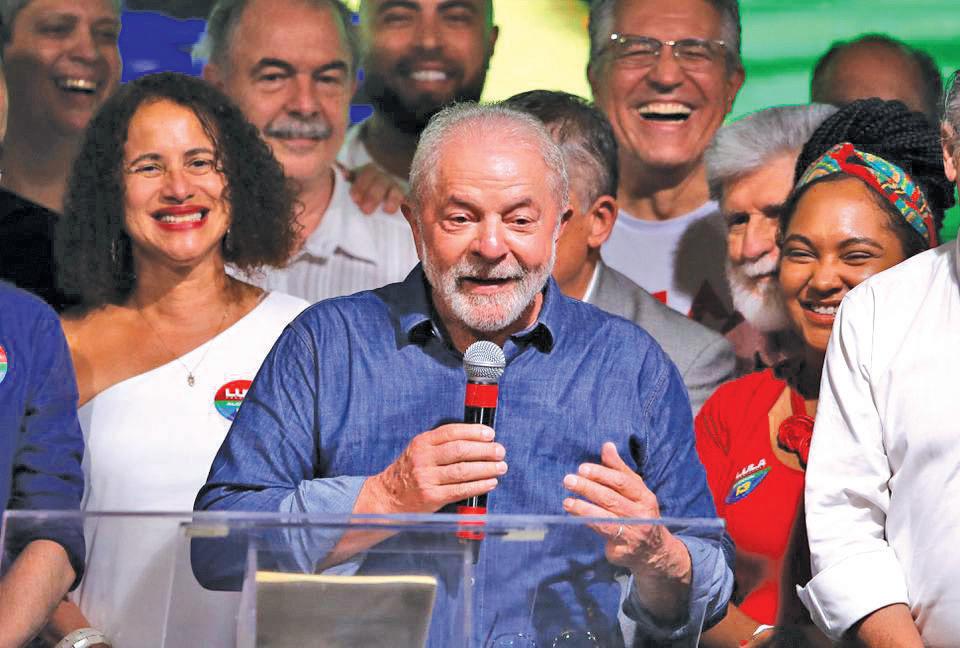

The BBC reported that there are just over 2.1 million votes sep arating the two candi
dates with 99.99% of votes counted.
In 2018, Bolsonaro led with over 10 mil lion votes more than Worker's Party candi date Fernando Haddad.

77-year-old Lula's inau guration is scheduled for January 1.
The vote was a rebuke for the fiery far-right populism of Bolsonaro, who emerged from the back benches of Congress to forge a novel conservative coalition, but lost support as Brazil ran up one of the worst death tolls of the COVID-19 pan demic.
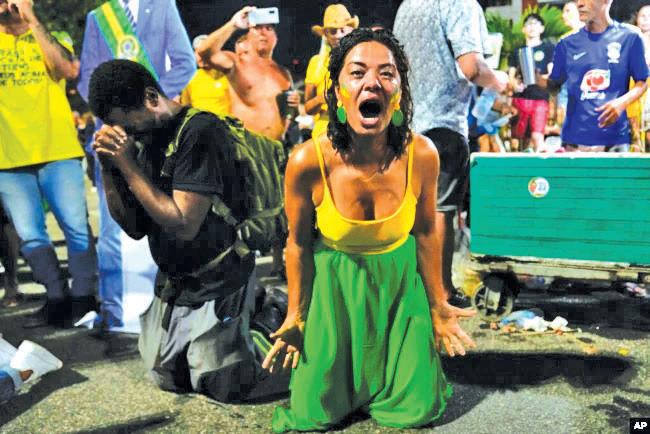
Bolsonaro, 67, who for years has made baseless claims that Brazil's voting system is prone to fraud, remained silent initially about the result. Electoral authorities are bracing for him to dispute the outcome, sources told Reuters, and made security preparations in case his supporters stage protests.
"Democracy," Lula wrote on Twitter, above a pho to of the Brazilian flag be neath his left hand, missing his little finger, the result of an accident he suffered as a metalworker decades ago.
He was greeted by ec static supporters at a ral ly on Sao Paulo's Paulista Avenue ahead of a planned speech. Vice President-elect Geraldo Alckmin and cam paign aides jumped up and down chanting, "It's time Jair, it's time to leave al ready," in a video circulat ing on social media.
Foreign leaders from US President Joe Biden to France's Emmanuel Macron to Argentina's Alberto Fernandez offered Lula messages of congratu lations.
Lula has vowed a return to State-driven economic growth and social policies that helped lift millions out of poverty when he was pre viously President from 2003 to 2010. He also promises to combat destruction of the Amazon rainforest, now at a 15-year high, and make Brazil a leader in global cli mate talks.
His victory consolidates a new "pink tide" in Latin America, after landmark
and he left office with re cord popularity.
However, his Workers Party was later tarred by a deep recession and a re cord-breaking corruption scandal that jailed him for 19 months on bribery con victions, which were over turned by the Supreme Court last year.
In his third term, Lula will confront a sluggish economy, tighter budget constraints and a more hos
leftist victories in Colombia and Chile's elections, echo ing a regional political shift two decades ago that in troduced Lula to the world stage.
A former union lead er born into poverty, Lula organised strikes against Brazil's military govern ment in the 1970s. His two-term presidency was marked by a commodi ty-driven economic boom
tile legislature. Bolsonaro's allies form the largest bloc in Congress after this month's general elec tion revealed the enduring strength of his conservative coalition.
Bolsonaro has repeat edly made baseless claims of electoral fraud and last year openly discussed re fusing to accept the results of the vote. (Reuters)


Ingrown toenails occur when the edges or cor ners of the nails grow into the skin next to the nail. The big toe is most like ly to get an ingrown toenail. Ingrown toenails are treat able at home. However, they can cause complications that might require medical treat ment. The risk of complica tions is higher if a person has diabetes or other condi tions that cause poor circu lation.
Ingrown toenails occur in both men and women. According to the National Health Services (NHS), in grown toenails may be more common in people with sweaty feet, such as teenag
ers. Older people may also be at higher risk because toenails thicken with age. Many things can cause an ingrown toenail, including:
• Cutting toenails incorrectly (Cut straight across, since angling the sides of the nail can encour age the nail to grow into the skin.)
Irregular, curved toenails
Footwear that plac es a lot of pressure on the big toes, such as socks and stockings that are too tight or shoes that are too tight, narrow, or flat for the feet
• Toenail injury, in cluding stubbing the toe, dropping something heavy on the foot, or kicking a ball repeatedly
• Poor posture
Improper foot hy giene, such as not keeping the feet clean or dry
Genetic predisposi tion
Using the feet extensive ly during athletic activities can make them especial ly prone to getting ingrown toenails. Activities in which it repeatedly kicks an object or put pressure on the feet for long periods of time can cause toenail damage and increase the risk of ingrown toenails. These activities in clude Dancing, Football, and Kickboxing





Ingrown toenails can be painful, and they usual ly worsen in stages. Earlystage symptoms include: Skin next to the nail becomes tender, swollen, or hard
• Pain when pressure is placed on the toe
Fluid building up around the toe
If the toe becomes infect ed, symptoms may include:
Red, swollen skin
• Pain
Bleeding
• Oozing pus
Overgrowth of skin around the toe
Treat the ingrown toe nail as soon as possible to avoid worsening symptoms.
The doctor will most like ly be able to diagnose the toe with a physical exam. If the toe seems infected, it might need an X-ray to show how deep the nail has grown into the skin. An X-ray can also reveal if the ingrown nail was caused by injury.
Ingrown toenails that ar en’t infected can normally be treated at home. However, if the toenail has pierced the skin, or there is any sign of infection, seek medical treatment. Signs of infection
include: Warmth, Pus red ness, and swelling
• Home treatment
To treat the ingrown toe nail at home, try:
• Soaking the feet in warm water for about 15 to 20 minutes three to four times per day (At oth er times, the shoes and feet should be kept dry.)
Pushing the skin away from the toenail edge with a cotton ball soaked in olive oil
Using over-thecounter medicines, like acet aminophen (Tylenol), for the pain
• Applying a topi cal antibiotic, such as poly myxin and neomycin (both present in Neosporin) or a steroid cream, to prevent in fection
Try home treat ments for a few days to a few weeks. If the pain worsens or there is difficulty walking or performing other activi ties because of the nail, see the doctor.
If the toenail does not re spond to home treatments or an infection occurs, it may need surgery. In cases of in fection, stop all home treat ments and see the doctor.
There are different types of surgical treatments for in grown toenails. Partial nail removal only involves re moving the piece of nail that is digging into the skin. The
doctor numbs the toe and then narrows the toenail. According to the NHS, par tial nail removal is 98 per cent effective for preventing future ingrown toenails.
During a partial nail re moval, the sides of the nail are cut away so that the edg es are completely straight. A piece of cotton is placed un der the remaining portion of the nail to keep the ingrown toenail from recurring. The doctor may also treat the toe with a compound called phenol, which keeps the nail from growing back.
Total nail removal may be used if the ingrown nail is caused by thickening. The doctor will give it a lo cal pain injection and then remove the entire nail in a procedure called a matrixec tomy.
The toenail will likely grow back a few months af ter a partial nail removal surgery. If the entire nail is removed down to the base (the nail matrix under the skin), a toenail can take over a year to grow back.
If left untreated, an in grown toenail infection can cause an infection in the bone of the toe. A toenail in fection can also lead to foot ulcers, or open sores, and a loss of blood flow to the in fected area. Tissue decay
and tissue death at the site of infection are possible.
A foot infection can be more serious if a person is diabetic. Even a small cut, scrape, or ingrown toenail may quickly become infect ed, due to the lack of blood flow and nerve sensitivity.
If there is a genetic pre disposition to ingrown toe nails, they may keep coming back, or appear on multiple toes at once. The quality of life may be affected by pain, infections, and other painful foot issues that require mul tiple treatments or surger ies. In this case, the doctor may recommend a partial or full matrixectomy to remove the toenails that are causing chronic pain.
Ingrown toenails can be prevented by making several lifestyle changes:
• Trim the toenails straight across, and make sure that the edges do not curve in.
Avoid cutting toe nails too short.
Wear proper-fitting shoes, socks, and tights.
Wear steel-toe boots if working in hazardous con ditions.
If the toenails are abnormally curved or thick, surgery may be necessary to prevent ingrown nails.
Haitian Prime Minister Ariel Henry has ex pressed outrage following the assassination of former presidential candidate Eric Jean Baptiste on Friday .
Baptiste, who was also the leader of a political par ty – the Rally of Progressive National Democrats, in the French-speaking Caribbean Community (Caricom) member state, was killed in the community of Laboule in the capital of Port-auPrince along with his body guard.
Baptiste also owned one of the biggest lottery compa nies in Haiti, “Pere Eternel”.
So far, there have been no arrests.
The assassination of Baptiste and his bodyguard
has again plunged the na tion into turmoil.
“We strongly condemn this heinous crime against this patriot, this mod erate politician commit ted to change,” said Prime Minister Ariel Henry in a message posted to social media. .
The killing occurred in
an area where the Ti Makak gang, which means “Little Macaques”, is fighting with the Toto gang for control of territory.
The community is lo cated near Pelerin, where President Jovenel Moïse was assassinated in his pri vate residence in July 2021. ( Nation News)
Association of Christian Communicators and Media (ACCM) has called on the Education Ministry in Jamaica to refrain from restricting devotions in pub lic schools.
The plea from the organ isation follows an incident that occurred during gen eral devotion at the Oberlin High School in the east ern parish of St Andrew on Wednesday.
The Education Ministry has been looking into the in cident in which several stu dents reportedly collapsed and started “speaking in tongues”, while others ap peared to be overwhelmed
with emotion after a female teacher prayed for them.
Education Minister Fayval Williams has since announced that the Ministry was working on protocols for devotions in schools.
In a statement on Friday, the ACCM said the proto cols should not dismiss the role of the church.

“The Ministry of Education must take into account the fact that the public school system, for the most part, was estab lished on moral and legal foundation, grounded in the Christian faith”.
“It is on this solid foun dation that the majority of the traditional institutions
of learning were built,” the group said, noting that Jamaica is now contend ing with a series of negative events.
The ACCM pointed to the “extraordinary high rates of crime and violence in the wider society is clear ly spilling onto school com pounds and the nation is be coming a dangerous place for all”.
“Jamaica has had the advantage of watching oth er countries dismantle the moral and Christian floor boards and observing the negative impacts on chil dren and families”.
(Excerpt from Jamaican Observer)
StPaul’s Anglican Church and the Manning family have paid their respects to the late Esther Manning, who died on Saturday morning at the age of 105.

Mrs Manning was the second wife of the late Arnold Manning, the father of the late Prime Minister Patrick Manning.
The murder toll for 2022 has now crossed 500 after the country record ed four more killings be tween Friday night and Saturday. A double murder at a cemetery in Tunapuna Saturday morning, a killing in Morvant Saturday morn ing and one in Enterprise on Friday night brought the toll to 501 up to late yesterday.
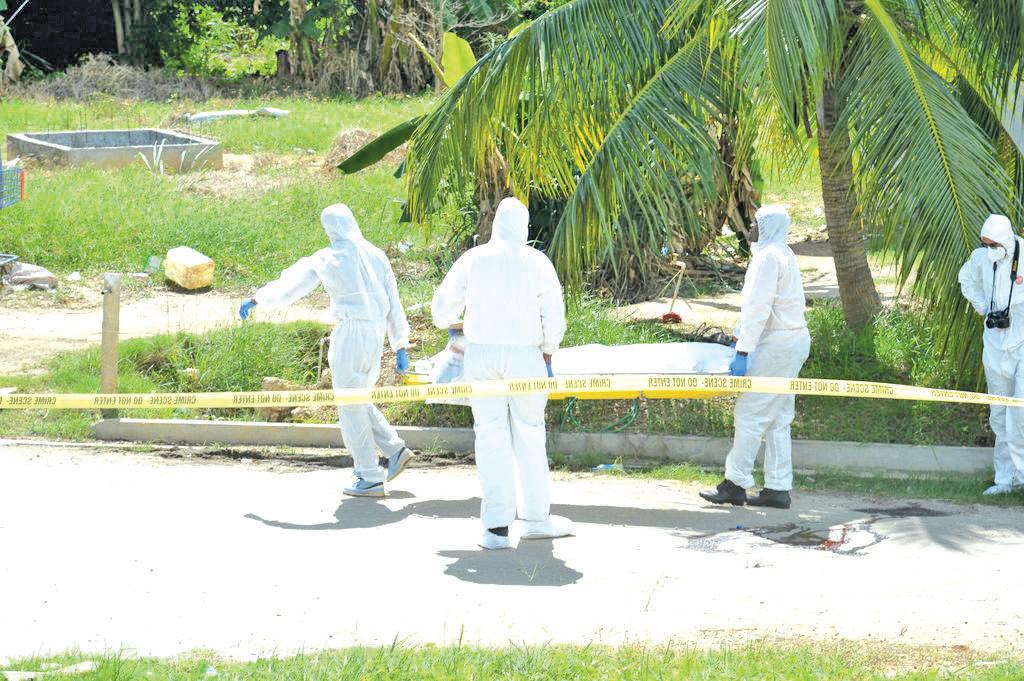
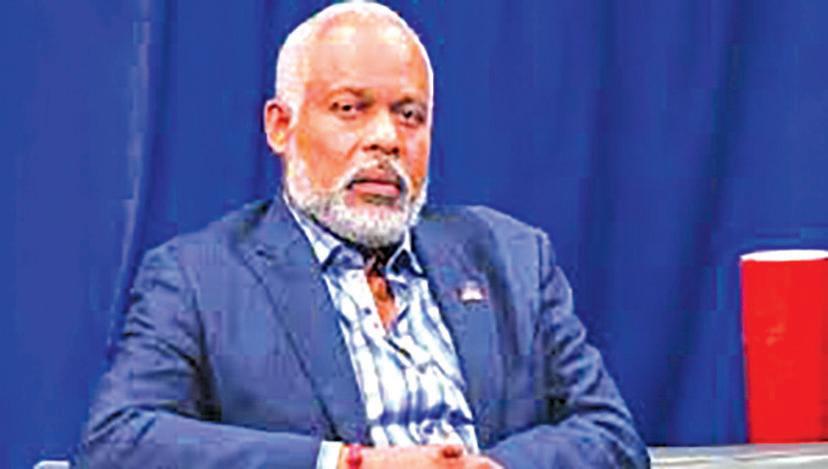
Two brothers, Nirmal Rambaran, 18, and Elvis Hernandez, 28, from Prescott Lane, Tunapuna, were shot dead at the Streatham Lodge Public Cemetery at 010:20 by gun men who opened fire on them after an altercation. A third man was rushed to the hospital after being injured in the shooting.
The father of the murder victims, Dalsingh Rambaran told the Sunday Guardian that he was at home when he received the news that his sons were killed.
"I thought they were shot
in the leg, but I didn’t know they were dead. They had an argument with some fel lows, but I don’t know where they are from. After the ar gument, the fellows re turned in a car and jumped out. Three were shot and one is in the hospital. One is a market vendor who took a day to clean the cemetery. The next son, Elvis came to
lime with his brother. None of my sons gave any trouble.
"This country is in trou ble. I wish my family and I could leave the country," a distraught Rambaran said.
According to police, the third victim who is in the hospital gave them critical information and investiga tions are ongoing. (Trinidad Guardian)
Air Canada on Friday resumed its opera tions to Cuba with Havana as destination, in correspondence to oth er foreign airlines that are also increasing their flights and routes for the winter season.
According to the Cuban Ministry of Tourism, the Canadian airline will have five direct weekly frequen cies to Havana.
The flight will also con nect Cuba and Japan, start ing in Tokyo to Vancouver,
Canada and then making the Toronto-Havana route.
For more than a de cade, Canada has been one of the main outbound mar kets for tourists to Cuba, and direct links are of spe cial significance for the is land’s tourism industry as it recovers after the pan demic.
Meanwhile, starting Sunday, Aeromexico will also resume flights to the island, with the Mexico City-Havana route and seven weekly frequencies.
With this reopening, the airline reaffirms its commitment to expand its connectivity network to link Mexico with the most important destinations in the world, its represen tatives said last August during the announcement.
Aeromexico began oper ations in Cuba since 2011 and stopped them in 2020 as a consequence of the pandemic and the health restrictions derived from it. (Excerpt from Nation News)
Contrary to earli er reports, Dr Petronella Manning-Alleyne clarified that Esther Manning was not her mother.
Manning-Alleyne said Elaine Johnson-Manning, who died in 1977, was the mother of Arnold’s five chil dren – Dr Pamela Manning, Panzetta Manning, Patrick, herself, and another child who died at the age of 17. After Elaine's death, Arnold married Esther, Elaine's sister.
Patrick Manning died on July 2, 2016.
San Fernando East MP Brian Manning, Patrick's son, said of Esther, “She was my grandmother’s sis ter, but she raised us as like our grandmother."
Esther died on Saturday morning at the fami ly’s Cocoyea Village, San Fernando home.
Anglican priest Rev Dr Knolly Clarke noted the loss of two of its stalwarts, Esther Manning and Wayne Charles, who he said both contributed to the musical life of the church.
Brian Manning acknowl edged Esther’s valued con tribution to the musical landscape of the Anglican Church, particularly St Paul’s Anglican on Harris Promenade, San Fernando, where he and his fami ly attended almost every
Sunday.
“She was a long-time manager of the St Paul’s Anglican Church. She managed the Sunday school, which I attended while growing up. She led the church choir and the Mothers' Union for an ex tended period of time.
Manning said she was very influential in his up bringing and in his becom ing the man he was today.
(Excerpt from Trinidad Guardian)
Member of Parliament for St Catherine North East, the Jamaica Labour Party’s Kerensia Morrison has described bad roads as “the biggest source of headaches for MPs”.
Morrison made the comment during her re cent contribution to the State of the Constituency Debate in the House of Representatives. Her com ment also came in the midst of mounting road blocks being staged in sev eral parts of the country over the poor state of the
nation’s roads.
During her presenta tion, Morrison urged the Minister of Finance, Dr Nigel Clarke, to increase the allocation for parochi al roads.
“Enable our councillors to take on even one road each year,” she pleaded to Clarke while arguing that “community roads are the Wi-Fi to connect people”.
Pointing out that St Catherine North East has been neglected for a long time, Morrison said “a new day has come”.
She told the House that
since being elected MP in September 2020, work has taken place on the Guys Hill main road, Riversdale through Williamsfield and Williamsfield to Mount Industry. She said the long-awaited Troja main road and York Street have been put to tender.
But, despite her opti mism, Morrison lament ed that the work that has taken place to date barely scratches the surface of the magnitude of work that is needed in the largely farm ing constituency. (Excerpt from Jamaica Observer)
Acting Commissioner tells cops to remain resilient as T&T’s murder rate crosses 500Haitian Prime Minister Ariel Henry Undertakers remove the bodies of brothers Nirmal and Elvis Rambaran from the Streatham Lodge Public Cemetery over the weekend San Fernando East MP Brian Manning and Esther Manning (Photo courtesy of Brian Manning)
Global energy giants including Exxon Mobil Corp and Chevron Corp posted another round of huge quarterly profits, benefiting from surging natural gas and fuel prices that have boosted inflation around the world and led to fresh calls to further tax the sector.
Four of the five largest global oil companies have now reported results, combining for nearly US$50 billion in net income, lifted by tight global markets and disruption following Moscow's invasion of Ukraine.
The sheer size of the profits has revived calls from politicians and consumer groups to impose more taxes on the companies to raise funds to offset the hit to households, businesses and the wider economy from higher energy costs. They have also criticised big oil companies for not doing enough to raise production to offset rising fuel and heating costs.

Chevron Chief Financial Officer Pierre Breber warned in an interview with Reuters that "taxing production will just reduce it."
The company reported its second-highest profit of US$11.2 billion. However, the company's global production is down so far this year from a year ago, and other US oil companies signalled that output in the topproducing US shale region is waning already.



"If you raise the costs on energy producers, it will decrease investment so that goes against the intent of increasing suppliers and making energy more affordable."
US President Joe Biden, who earlier this year said Exxon was making "more money than God", told oil companies this month that they were not doing enough to bring down energy costs.
Hours after Shell reported a quarterly profit of US$9.45 billion and raised its dividend by 15 per cent on Thursday, Biden said the company was misusing its profits.
On Friday, he noted on Twitter in response to a comment from Exxon's CEO that "giving profits to shareholders is not the same as bringing prices down for American families."
In the UK, the President of the COP26 climate summit Alok Sharma said on Friday that Prime Minister Rishi Sunak's Government should explore extending a windfall tax on oil and gas firms.
Shell CEO Ben Van Beurden has said the energy industry "should be prepared and accept" that it will face higher taxes to help struggling parts of society. Shell earned more than US$9 billion in the third quarter, putting it on track to surpass its record annual profit of US$31 billion set in 2008.
Exxon Mobil, the largest US major, reported nearly US$20 billion in net income in the quarter ending in September, exceeding expectations and surpassing its previous record set just three months earlier.
Exxon led the five oil majors in overall revenue, nearly doubling its peers Shell and TotalEnergies in the quarter. Exxon's shares lagged those companies' stocks for several years, but have rebounded in 2022 even as it has not made the same commitment as its European competitors to ramp up spending in renewables. BP Plc, the fifth major, reports results this week.
Shares of the five majors have all posted a total return of at least 29 per cent this year. Exxon leads the way with an 86 per cent increase, while the broad-market S&P 500's total return is minus-19 per cent on the year, according to Refinitiv Eikon data.
European Governments have scrambled to fill gas storage after Russia cut off most of its natural gas exports to the continent, its primary customer.
On Friday, Norway's Equinor also broke new ground helped by the all-time high in European gas prices, and Italy's Eni nearly tripled its profit from a year ago, beating the consensus with earnings of 3.73 billion euros (US$3.72 billion). France's TotalEnergies reported a record profit of US$10 billion on Thursday. (Excerpt from Reuters)
At least 81 people were killed in the west ern Indian state of Gujarat on Sunday when a footbridge packed with sightseers enjoying holiday festivities collapsed and plunged them into the riv er below.
Reuters TV footage showed dozens of people clinging onto the cables and twisted remains of the bridge over the Machhu River in the town of Morbi as emergency teams strug gled to rescue them.
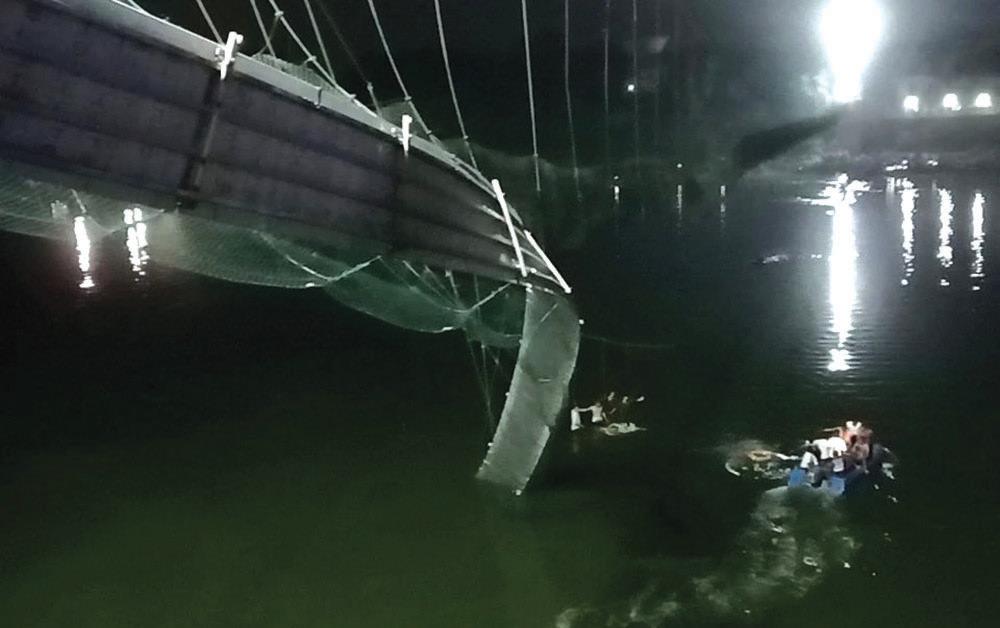
Some clambered up the broken structure to try to make their way to the river banks, while others swam to safety. A number of chil dren were among the vic tims.
Atul Prajapati, a medi cal officer at the state hos
pital near the disaster site, said: "We have found 81 bodies and the final rites process has begun."
Dozens of people were also injured, officials said.
Authorities said more than 400 people were on and
around the colonial-era sus pension bridge at the time of the collapse. State Home Minister Harsh Sanghavi said more than 150 people were on the bridge itself.
The bridge had drawn many sightseers celebrat
ing the Diwali, or festival of lights, and Chhath Puja holidays.
"Many children were en joying holidays for Diwali and they came here as tour ists. All of them fell one on top of another. The bridge collapsed due to overload ing," said one witness, who gave his name as Sukram
The 230-metre bridge was built during British rule in the 19th century. It had been closed for renova tion for six months and was reopened for the public last week.
Prime Minister Narendra Modi, who is in his home state Gujarat for a three-day visit, said he had directed the state chief min ister to mobilise teams ur gently for the rescue opera tion. (Excerpt from Reuters)
Eleven people were killed in a stampede at a packed con cert headlined by African music star Fally Ipupa at the biggest stadium in the Democratic Republic of the Congo’s capital, the coun try’s Interior Minister has said.
Interior Minister Daniel Aselo Okito on Sunday blamed the organ isers for the deaths, saying
the Martyrs’ stadium con cert in Kinshasa “went be yond 100 per cent capaci ty”.
The stadium was packed beyond its capac ity of 80,000 and some of the crowd ended up forcing their way into the VIP and reserved sections, report ers of Reuters news agency at the concert said.
“Eleven people dead … including two Police,” the
Twin car bomb explo sions near a busy junction in Somalia's capital, Mogadishu, killed at least 100 people, President Hassan Sheikh Mohamud said.
Among the victims "who were massacred [were] mothers with their chil dren in their arms", the AFP news agency quotes the president as saying.
He appealed for inter national medical help to deal with the 300 injured.
The President blamed the al-Shabab militant group for Saturday's at tack which targeted the Education Ministry.
The pro-jihadist Somali Memo website has report ed that the group has said it was behind the blasts.
An affiliate of al-Qae da, al-Shabab has engaged in a long-running conflict with the federal Somali Government.
President Mohamud, in power for five months pledged "total war" against the Islamist militants af ter they attacked a popu lar hotel in Mogadishu in August killing at least 21
people.
Saturday's blasts hap pened within minutes of each other, destroying buildings and vehicles in the vicinity.
The first hit the Education Ministry and then the second went off as medical teams arrived to deal with the aftermath, the Reuters news agency reports.
A lorry exploded at the same junction almost ex actly five years ago, leav ing more than 500 people dead - the worst such at tack in the country's his tory.
After Saturday's at tack, hundreds of people have gathered near the site, looking for missing family members.
Among those killed were a prominent journal ist and senior police offi cer.
The African Union (AU) mission in Somalia said that the "attacks underline the urgency and critical importance of the ongoing military offensive to fur ther degrade al-Shabab".
(Excerpt From BBC News)Minister told reporters at the stadium, sending con dolences to relatives of the casualties.
He said he deplored the “loss of human life” and said the organisers “must be punished”.
Security forces had earlier fired tear gas to disperse violent crowds in the streets outside the stadium where many had gathered before the concert by Kinshasa-born Ipupa.
The 44-year-old is one
of Africa’s leading musi cians whose albums sell worldwide.
Singer-songwriter Ipupa, “like all Congolese singers”, had arrived sev eral hours after the show had been scheduled to start, the agency noted.
The eventual number of attendees inside the stadium vastly exceeded the number of state and private security person nel present could control.
(Excerpt from Al Jazeera)London's Natural History Museum and Cambridge University have said that they are ready to co-oper ate with Zimbabwe to re turn human remains that were taken in the colonial era.
The fresh statements come after a delegation from Zimbabwe held talks with officials from both in stitutions.
The Zimbabweans are looking for the skulls of late-19th Century anti-co lonial heroes, which they believe could be in the UK.
But these have not yet been found.
The authorities in Zimbabwe have long sus pected that the remains of some of the leaders of an uprising against British rule in the 1890s - known as the First Chimurenga - were taken to the UK as trophies.
During the colonial era, body parts were sometimes
removed from battlefields or dug up from graves ei ther as trophies or for re search into a now-discred ited scientific field.
In the 19th Century, phrenology, which investi gated the idea that human characteristics could be determined by the shape of the skull, was very popular in the UK and other parts of Europe. Phrenological societies would collect skulls to help develop the theory, which for some ex tended to racial classifica tion.
Some researchers set out to show that skull shape indicated that peo ple from different parts of the world were inherently inferior.
Some of the archives that now exist in the UK are amalgamations of what had been amassed by defunct phrenological soci eties as well as private col lectors. (Excerpt from BBC News)
Seek out someone you can count on instead of trusting someone without a



record. Set an example for oth ers and see who rises to the occasion. Surround yourself with stellar individ uals.











Make changes that work for you and refuse to let outsiders interfere with your decisions. Put your power behind what matters to you, and don't agree to unnecessary and costly plans.
Head in a direction that interests you, and you will find many ways to use your skills. Sharing with peers is no ble, but don't expect the same in return. Recognize who is competing with you.


Explore the possibilities, and you'll find a way to use your attributes, skills and experience to create something unique. Put on your thinking cap to de vise a better way to get things done.
Proceed with caution. Don't make promises you can't keep or limit what you can do. Refuse to let anyone take ad vantage of you. Concentrate on whatev er benefits you directly.

Attend a meeting, conference or class and soak up information that will invig orate you. Liking what you do for a liv ing is healthy. Don't settle for something that doesn't speak to you.






Focus on your responsibilities. Leave nothing to chance. Be on guard, resource ful and prepared to implement different methods to reach your goal. Branch out and learn as you go.
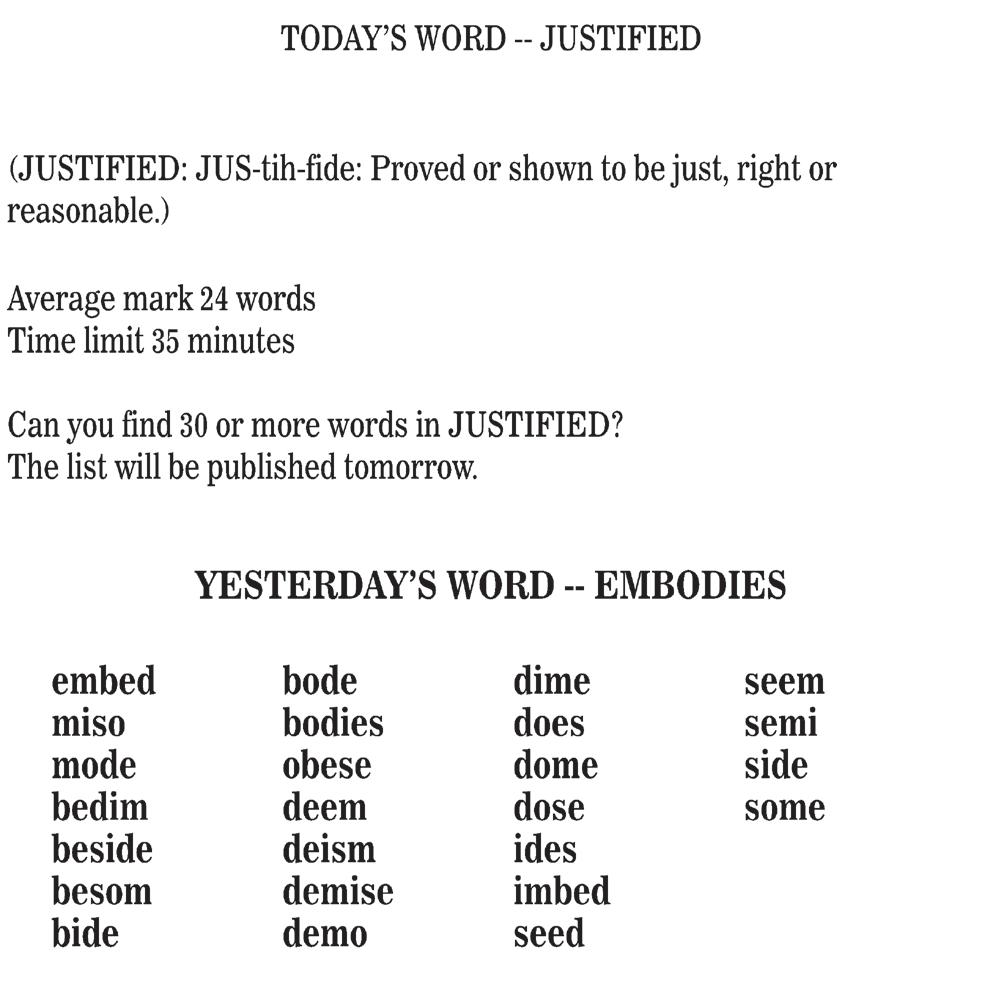




Confirm the information you receive and pass along only what's valid. Don't let anger set in if someone reschedules or makes an unexpected change. Reset your plans if needed.


Stay in your comfort zone. Refuse to let anyone take advantage of your good nature or generosity. Don’t let uncer tainty set in regarding what others ex pect of you.

Look at the possibilities, use your imagination and call on people you know won't let you down. Don't mix business with pleasure. Keep private matters to yourself.
Make stability a priority. Choose your words carefully when discussing money matters or relationship issues. Uncertainty will put you in an awkward position. When in doubt, take a pass.
Work toward achieving financial sta bility. Handle an incident at home with care. An argument will make matters worse. Bide your time; plan to nurture rather than start a feud.




SouthAfrica moved to the top of the group 2 points table and boosted their chances of making the semi-finals after recovering from 24 for 3 to successfully chase 134 against India. Aiden Markram and David Miller were the architects of South Africa's triumph, scoring half-centuries each and sharing a 76-run fourth-wicket stand.
On a pacy pitch, South Africa's quicks set the tone with hard lengths and plenty of speed. They reduced India to 49 for 5 in the ninth over before Suryakumar Yadav held the innings together with his 11th T20 International half-century but he lacked support. He shared a 52-run partnership with Dinesh Karthik, who scored only six of those runs. Lungi Ngidi and Wayne Parnell were the main beneficiaries of South Africa's approach and took seven wickets between them but all the quicks were impressive.
Anrich Nortje brought the heat on a chilly evening and clocked over 150kph with regularity while Kagiso Rabada, for a change, played only a supporting role .
India's attack was also impressive as they made use of fuller lengths and found swing. Some of the differences between the two sides lay here. South Africa bowled 50 short or short-of-agood-length deliveries and took six wickets for 34; India bowled 48 and took one for 53.
In the end, both captains also had to gamble on how they used their spinner. Temba Bavuma can't catch a break with the bat and failed again, but made the right decision to only use Keshav Maharaj for three overs, while giving Markram one. Between them, they conceded 33 runs in four overs. Rohit Sharma bowled R Ashwin out and used him in
the 18th over. By then, Markram was out, but Miller was still at the crease and South Africa needed 25 runs from 18 balls. Ashwin's over cost 13 runs and though he dismissed Tristan Stubbs, Miller finished it off for South Africa.
This result has big implications for the rest of the group, particularly Pakistan, whose semi-final hopes are hanging by a thread. South Africa's win means that not only do Pakistan have to beat South Africa on Thursday, but also hope either India lose to Bangladesh and Zimbabwe or South Africa are beaten by the Netherlands.
India had a curious start against the swinging ball and took 10 deliveries to get off the mark – the longest in their T20I history – before both openers breached the big boundaries. Sharma hooked Rabada over fine leg and KL Rahul whipped Parnell over midwicket, but neither scored too much more. Ngidi was introduced in the fifth over and made an immediate impact with hard lengths. Rohit mis-hit his first delivery over the covers, but it fell safely. Then, he was cramped on the pull, the ball caught the
splice of the bat and went straight up, giving Ngidi enough time to saunter across the square and take the catch. And Ngidi was just getting started. At the end of that over, Rahul was foxed by the extra bounce and edged a ball he looked to guide to third man. Markram was perfectly positioned, almost on the edge of the ring, at slip to take the catch. India were 26 for 2 and finished the powerplay on 33 for 2.

Virat Kohli mounted a brief riposte with back-toback boundaries against Ngidi ,but when he tried to take on the bouncer, he got it wrong. Kohli sent a pull towards fine leg where Rabada ran around the corner from a deep-square position to take a good running catch, as casually as you like.
Like Ngidi, Rabada also went one better. In Ngidi's next over, Hardik Pandya took his chances against the short ball and pulled to fine leg. He connected well, but not well enough and did not get the distance he was looking for. Rabada did and ran from the boundary rope and leapt forward and took a diving catch with both hands, even as both feet left the floor. India were 49 for 5.
Reach for the SKY Suryakumar scored more than half of India's total runs and more boundaries than any of their other batters combined. Apart from his opening boundary – an edge that flew over first slip off Nortje – he timed and placed his shots well and took on the short ball with a level of discernment. He used his wrists particularly well, targeted Maharaj, which forced Bavuma to turn to Markram for an over, and then dented Ngidi's figures when he took 11 runs off his final over. Overall, Suryakumar scored 25 runs off the 12 balls he faced from Maharaj. His 68 came at a strike rate of 170, while the rest of India's line-up contributed 57 runs at a strike rate of 71.25. In the process, Suryakumar became the highest run-scorer in T20Is in 2022, going past Mohammad Rizwan.

While South Africa used bounce to make their early incisions, India relied on swing. Arshdeep Singh struck with his first ball, which swung away from Quinton de Kock, who chased it and nicked off. Two balls later, he hit Rilee Rossouw on the back pad. Arshdeep thought the movement was taking the ball wide of leg stump, but Rohit disagreed. He reviewed, with balltracking showing that it would go on to hit the top of middle and leg. Rossouw was dismissed for his third duck in five innings, all at the hands of Arshdeep. In between that, Rossouw has scored two centuries. In nine deliveries, South Africa were 3 for 2 and things didn't get much better. Bavuma's blues continued as he tried to ramp Mohammed Shami over the wicketkeeper, but
inside-edged to Karthik instead. South Africa ended the powerplay at 24 for 3.

Markram makes his move South Africa limped to the halfway mark in their innings on 40 for 3 and needed to change gears after the drinks break. Markram took on Pandya's short balls and found the boundary twice in three balls before putting pressure on India fielders by responding to Miller's call for a quick single. Miller tapped the ball to backward point, Suryakumar swooped in and shied at the striker's end, but missed. Then Markram took on Ashwin, advanced down the pitch, and hit a carrom ball for four before heaving it to deep midwicket
where Kohli juggled and then dropped the catch. Markram was on 35 at the time. With 25 runs scored off the 11th and 12th over combined, India were forced to bring back a frontline seamer early. Shami's third over only cost three runs, but India squandered a third opportunity for a wicket. Miller fended a delivery and Markram was already two-thirds of the way down, so Miller ran. Rohit had three stumps to aim at, but missed. Ashwin continued and so did Markram, but not before Miller cleared his front leg to hit Ashwin for six over longoff. Markram then sent him over long-on for six more. South Africa scored 45 runs in the four overs after drinks to set themselves up for the win. (ESPNcricinfo)
Lungi Ngidi 4-0-29-4
Anrich Nortje 4-0-23-1 Keshav Maharaj 3-0-28-0
Aiden Markram 1-0-5-0
South Africa (T: 134 runs from 20 ovs)
Quinton de Kock †c Rahul
b Arshdeep Singh 1
Temba Bavuma (c) c †Karthik

b Mohammed Shami 10 Rilee Rossouw lbw
b Arshdeep Singh 0
Aiden Markram c Yadav b Pandya 52 David Miller not out 59
Tristan Stubbs lbw b Ashwin 6 Wayne Parnell not out 2 Extras (b 4, lb 2, w 1) 7

TOTAL 19.4 Ov (RR: 6.96) 137/5
Fall of wickets: 1-3 (Quinton de Kock, 1.1 ov), 2-3 (Rilee Rossouw, 1.3 ov), 3-24 (Temba Bavuma, 5.4 ov), 4-100 (Aiden Markram, 15.4 ov), 5-122 (Tristan Stubbs, 17.4 ov)
BOWLING O-M-R-W
Bhuvneshwar Kumar 3.4-0-21-0
Arshdeep Singh 4-0-25-2 Mohammed Shami 4-0-13-1
Hardik Pandya 4-0-29-1
4-1-15-3 Kagiso Rabada 4-0-26-0
Ravichandran Ashwin 4-0-43-1
Pakistan produced a superb bowling performance to restrict Netherlands to 91-9 in their crucial Group 2 encounter in Perth and seal a six-wicket win, their first victory in the T20 World Cup in Australia.

Chasing the total down, Mohammad Rizwan set the tone early with a superb shot down the ground. It wasn't such good luck for his partner and skipper Babar Azam, as he was run out for four. It is the first time in his T20I career that Babar has been dismissed three times in a row for a score of under 10.
A partnership would then develop between Rizwan and Fakhar Zaman. The pair established a stand of 37 off 31 deliveries which helped Pakistan motor along in their small chase. Fakhar's knock of 20 would come to an end against the bowling of Brandon Glover, with Scott
Edwards taking a terrific diving catch behind the stumps.
Rizwan would continue to guide Pakistan towards the target, but missed out on his half-century by a mere one run, with Paul van Meekeren getting his prized scalp.
While Pakistan went on to lose another wicket with the scores level, they completed
the win with enough overs in the bank. It was Pakistan's first win in the tournament, and notably their first-ever win in Australia in T20Is.
Pakistan produced a brilliant bowling effort, restricting Netherlands to a low score. They made full use of the pace and bounce on offer on a quick Perth wicket. Netherlands never got going
against the varied Pakistan bowling attack, managing to score only 19 runs in the powerplay.
Shadab Khan then did all the damage in the middle overs, ending his spell with superb figures of 3-22 in his four overs. The pace quartet of Shaheen Afridi, Haris Rauf, Mohammad Wasim, and Naseem Shah were also superb, with Netherlands finding it hard to counter them.
Colin Ackermann (27 off 27) was the only Netherlands batter who got his eye in and played a couple of cheeky shots. asim would produce a sizzling 19th over, bowling two superb yorkers to further dent Netherlands' efforts to add a few valuable runs.
In the end, Netherlands could only post a total of 91-9 on the board in their 20 overs, as it was a job well done with the ball for Pakistan. (ICC)
18.3 ov), 9-91 (Paul van Meekeren, 19.6 ov)
BOWLING O-M-R-W
Naseem Shah 4-0-11-1
Mohammad Wasim 3-0-15-2
Haris Rauf 3-0-10-1
Shadab Khan 4-0-22-3
Mohammad Nawaz 2-0-11-0
Pakistan (T: 92
Mohammad Rizwan
Edwards b van Meekeren
Shan Masood
Meekeren
TOTAL 13.5 Ov (RR: 6.86)
Fall of wickets: 1-16 (Babar Azam, 1.6 ov), 2-53 (Fakhar Zaman, 7.1 ov), 3-83 (Mohammad Rizwan, 12.1 ov), 4-91 (Shan Masood, 13.3 ov)
BOWLING O-M-R-W
Fred Klaassen 3-0-26-0 Paul van Meekeren 4-0-19-1 Brandon Glover 2.5-0-22-2
Tim Pringle 1-0-12-0
Logan van Beek 2-0-9-0 Roelof van der Merwe 1-0-7-0


West Indies strokemaker Keacy Carty hit his second regional One-Day hundred to help Leeward Islands Hurricanes avert danger and clinch a three-wicket win over a plucky West Indies Academy in the opening game of the Super50 Cup in Antigua on Saturday.
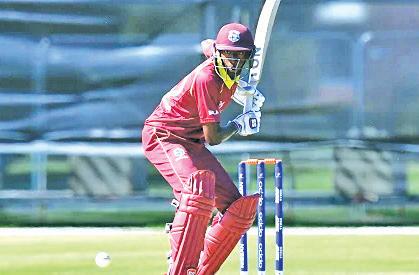
With the hosts languishing on 27 for three in the ninth over in pursuit of 191 at the Vivian Richards Cricket Ground, the righthanded Carty stepped up with an unbeaten 103 from 120 balls which put his side over the line at the end of the 39th over.
The only other batsman to pass 20 was Terrance Ward with an unbeaten 23 from 30 deliveries, combining with Carty in a crucial seventhwicket stand worth 56 to defy the Academy side.
Earlier, the Academy had been limited to 190 for nine from their 50 overs, discarded Test off-spinner Rahkeem Cornwall snatching
35.
Kevin Wickham topscored with 44 from 47 balls with four fours and two sixes, posting 68 for the third wicket with Keagan Simmons who made 43 from 73 balls,
They were eventually part of a slide that saw three wickets tumble for 33 runs, but Kevlon Anderson struck 35 from 67 balls in a 42run, sixth-wicket stand with Leonardo Julien (18 not out) to salvage the innings.
Left-arm spinner Joshua Bishop (4-40) then handed the Academy side a superb start when he removed veteran openers Kieran Powell (8) and Devon Thomas (0) to catches at first slip by Teddy Bishop, leaving Hurricanes tottering on 23 for two in the seventh over.
And when he got Karima Gore to sky to backward point in the ninth to claim his third wicket, Hurricanes were struggling early in their run chase.
Carty, who counted 10 fours and two sixes, then patched up the innings in a series of partnerships, first adding 51 for the fourth
wicket with Captain Jahmar Hamilton (11), 21 for the fifth with James (7) before anchoring another halfcentury stand with Ward.
When Ward perished at the start of the 34th with the contest still in the balance, Hayden Walsh Jr (18 not out) arrived to put on 33 in
an unbroken, eighth-wicket stand with Carty and further frustrate the emerging players. (CMC)
The tournament will continue today with Guyana Harpy Eagles playing
Windward Islands Volcanoes at Queen's Park Oval Trinidad from 09:00h, and Trinidad and Tobago Red Force will play CCC at Brian Lara Cricket Academy at 13:00h Eastern Caribbean time.

(10-2-25-1)
Terance
Leeward
Ackeem
Keagan
Kevlon
Bowling
Rahkeem
Kofi
(20.2)
(43.3)
(44.4)
(47.1)
(47.3)
(6-0-31-1)
(10-1-42-4)
(4-0-23-0)
(10-1-35-2)
(10-0-31-1)
Ward
Walsh
Wickham
out
(7 wickets, 39.0) (16
3/1 (0.5) Devon Thomas 23/2 (6.4) Kieran Powell 27/3 (8.4) Karima Gore 78/4 (16.6) Jahmar Hamilton 99/5 (22.6) Kofi James 102/6 (25.1) Rahkeem Cornwall 158/7 (33.1) Terance Ward
Joshua Bishop (10-1-40-4)
Layne (4-0-18-0) McKenny Clarke (6-1-28-1) Kevlon Anderson (3-0-19-0) Joshua James (7-0-44-1) Kevin Wickham (9-0-39-1)
Led by an all-round performance from Tameshwar Mangal, Albion defeated Port Mourant by 20 runs in the final of the Berbice Cricket Board (BCB)/ Kevin Sinclair Under-17 tournament played at the Area H Ground in Rose Hall Town on Saturday.

Batting first, Albion posted 137 all out in 36.5 overs. Ari Afrizal Kadir topscored with 42, inclusive of four boundaries and one six, while Afraz Budhoo (17) and
Mangal (14) contributed with the bat. Mangal and Kadir added 65 runs for the opening stand for Albion, laying a good platform. Wickets then fell in the middle order at regular intervals, with Port Mourant spinners creating problems. Extras contributed 16 runs to Albion's total.
Bowling for Port Mourant, Ravin Boodwah had 2-14 from six overs while experienced off-spinner Salim Khan had 2-28 in eight overs.
In response, Port Mourant
managed 117 all out in 33.2 overs. Khan made a promising 27, while national player Navin Boodwah scored 25 and Ravin Boodwah contributed with 14. Port Mourant's highest batting partnership was 29, with Khan dominating. He was key for a Port Mourant win, but he departed after hitting three fours in his 49-ball 27.
Bowling for Albion, Mangal had figures of 3-23 in 6.2 overs and seamer Shiv Harripersaud had 3-22 from eight overs. (Brandon Corlette)
The Guyana Defence Force (GDF) team emerged as the Inter-Services Road Relay champions following a riveting run on Sunday morning.
The degree of competition among the teams was at the usually high level, with the athletes giving it their all in their efforts to better each other. The supportive energy was also great among members of the public who lined the relay route, to witness yet again, the rivalry between the GDF and the Guyana Police Force (GPF) athletes.
The race, which comprised five legs, began in the vicinity of the Felix Austin Police College and saw the athletes running all the way up the Rupert Craig Highway before making a U-turn at the junction of UG road and culminating at GPF Headquarters. The fivemember teams comprised four males and a lone female
who ran the last leg of the race.
Following the break of the race by Chief of Staff, Brigadier Godfrey Bess, the GDF athletes grabbed an early lead, thanks to Recruit Matthew Gordon who then smoothly passed the baton to Lance Corporal Marlon Nicholson. Corporal Odwin Tudor kept pace and passed the baton to Reservist Devaun Barrington. Private Tia Azore finished the race with a gap so wide her counterparts could not be seen even after she crossed the finish line.
The GPF placed second followed by the Guyana Fire Service in third, the Guyana Prison Service in fourth and the City Constabulary in fifth.

Chief of Staff Bess and Commissioner of Police (ag), Clifton Hicken congratulated the teams, and urged members of the Joint Services to remember that a win by any team is a win for the entire Joint Services.
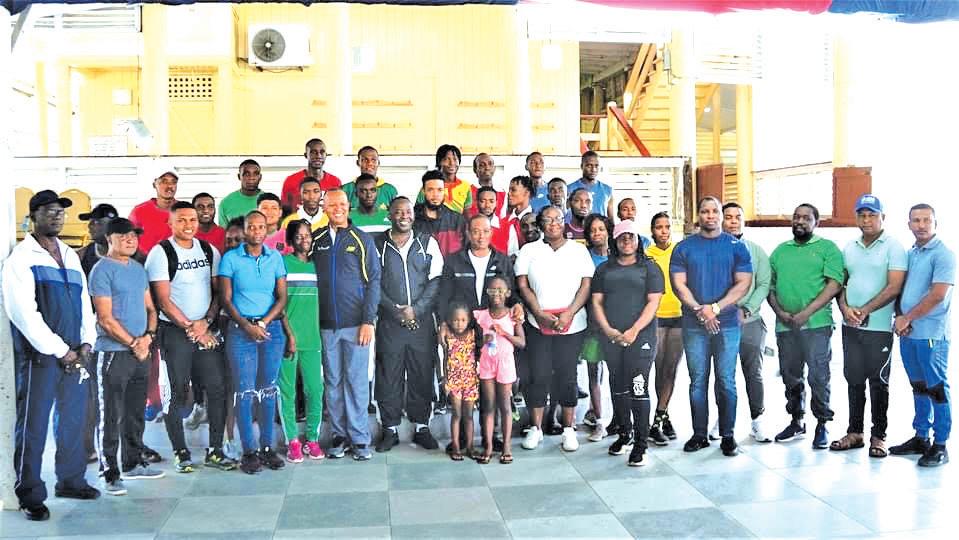
PANDITH YOGI will give you solu tions and suggestions for any kind of problems, such as LOVE, HEALTH, HUSBAND AND WIFE PROBLEMS, SEX, GOOD LUCK, BUSINESS, HOUSE PROTECTION. Contact Pandith, you will get result 100% guaranteed. Call or WhatsApp +592 672-8346. Address Georgetown.
Contact PANDITH JAYA for all kinds of problems. You will get solutions 100% guarantee. Call or WhatsApp +592 688-1569. Address Georgetown.
DOMESTIC – to work in Georgetown from 7.00am to 3.00pm (4-5 days per week). Telephone: 623-6383
Mill factory workers needed Monday to Friday $3500 per day. Call 611 – 7839
Sales representative: must have valid lorry license. CXC subject
1
3. Call 611 – 7839.
Guyanese Tagenarine
Chanderpaul is set to open the batting with West Indies Captain Kraigg Brathwaite in Australia next month. Moments after his selection was made public, the 26-year-old Chanderpaul said playing for the West Indies was a childhood dream.
The left-hander explained that the key to success was to get acclimatised and sticking to his solid game plan. Chanderpaul said: "Obviously excited to get the call. It's been a childhood dream to play for the West Indies."
Australia is no easy place to debut, but young Chanderpaul is up for the challenge. "I think as always, you try to see off the new ball but when you get in, you just try to make the best use of it. Hopefully get a few practice sessions in to get accustomed to the pitches
and try to get in and get some scores," he said.
Chanderpaul, who scored a fine century against Bangladesh A earlier this year and dominated the final three rounds of the Regional Four-Day, relished those experiences. He said playing against Bangladesh was good as he got to mix
around international players and scored. "… it was nice to play with some international players in the Bangladesh A series and get runs against them."
The solid left-handed opener – who has 50 FirstClass matches under his belt, with five centuries
and 10 half-centuries, also credited his grandfather, who was the man behind his training sessions at home.
"Growing up my grandfather was the one who would practice me at home, take me to practice and games, so I credit it to him and I'm sure he is happy," Chanderpaul said.
Meanwhile, Cricket West Indies (CWI) Lead Selector Desmond Haynes said Chanderpaul has what it takes to do well in Australia.
"We have one newcomer to the team in Tagenarine Chanderpaul. He acquitted himself very well in the West Indies Championship fourday matches and also did a very good job at the top of the order against Bangladesh A in Saint Lucia this summer. He has what it takes to do well at the highest level.”
Haynes added.
Tagenarine, son of former West Indies batting star Shivnarine Chanderpaul, made his First-Class debut against Leeward Islands in 2013, and has, to date, accumulated 2669 First-Class runs, at an average of 34.21.

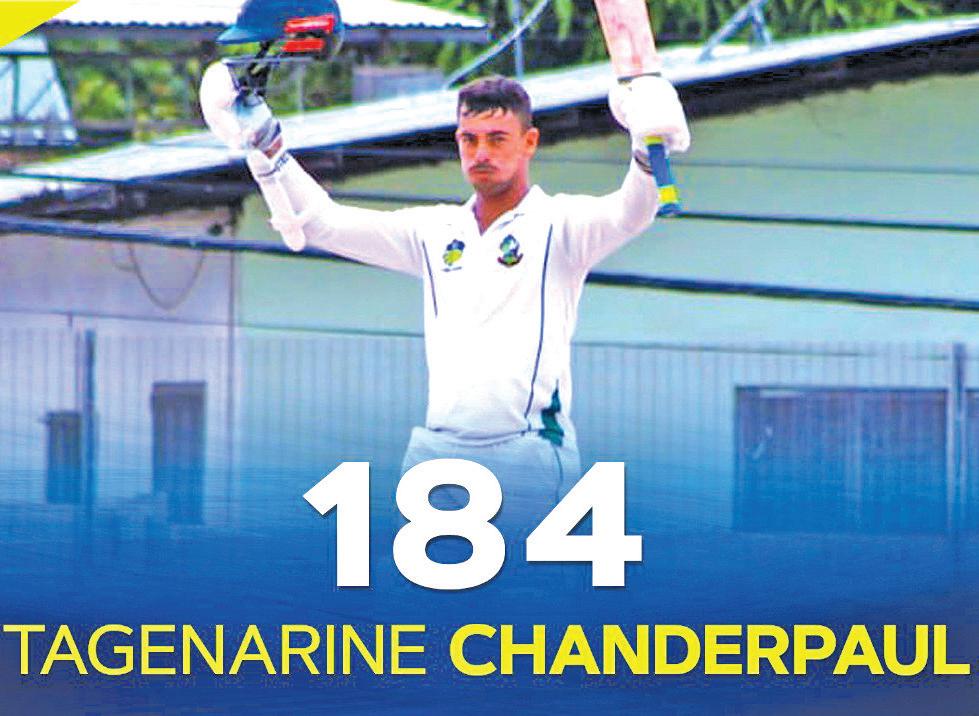
The West Indies Test squad is expected to assemble in Australia on November 10. As part of the preparations for the twomatch series the visitors will have a three-day warm-up game against an ACT/NSW XI at the Philip Oval, Canberra on Thursday, November 17 to Saturday, November 19.
This will be followed by a four-day pink ball match against the Australia Prime Minister’s XI at the Manuka Oval in Canberra on Wednesday, November 23 to Saturday, November
26. The day/night match will be played under lights and will commemorate the anniversary of the inaugural fixture in 1951, also against the West Indies.
The Test series will be contested for the prestigious Frank Worrell Trophy –named in honour of the legendary West Indies Captain. The series will also form part of the ICC World Test Championship.
WI Full Test Squad: Kraigg Brathwaite (Captain); Jermaine Blackwood (Vice Captain); Nkrumah Bonner; Shamarh Brooks; Tagenarine Chanderpaul; Roston Chase; Joshua Da Silva; Jason Holder; Alzarri Joseph; Kyle Mayers; Anderson Phillip; Raymon Reifer; Kemar Roach; Jayden Seales and Devon Thomas.

The excitement is heating up for the November 6 grand one-day horse race meet at the Port Mourant Turf Club.
According to race organisers, more than 50 horses have been entered into the event, with some big names set to take centre stage. More than five million dollars will be up for grabs in this thrilling meet.
Notable entries thus far are "Our Stuie", who is returning after placing third at the Guyana Cup; "Lookin to Heaven", the recent winner at Bush Lot, West Coast Berbice; Jessica Pride (second-place horse at President's Cup); "Coup d etat" (third-place finisher at President's Cup); and Golden Blue Ecko (second-place finisher at Kennard’s Memorial).
Additionally, Everesting and Vera’s finally from Master Z and Jumbo Jet Stables are also expected to feature.
For the two-year horses, 10 entries are registered to date. Among those horses are Starlight, Red Ammunition, Legacy, Top Gun, and Party Hard.
In the G class race: Nuclear Fire, American Traveller, Princess Steffani, Memories, and Golden Dor.
The J Class race should be a thriller, with a rematch between Red Jet and Foreign Link. Skittles, Cash Return, and Miss Olympic are also listed for this race.
Seven races are on the cards and the winner of the feature race will bag one million dollars. The first race will be the L Open, for which a top prize of $200,000 would be paid.
Race two will be for twoyear-old maiden animals, and the top horse will bag $400,000 while the second-placed horse would collect $200,000.
The J Class non-starter and unplaced 2022 race will see the top horse bagging $200,000.
The H & Lower race, which is the fourth race of the day, would see the top horse being rewarded with $500,000. The K & Lower race will see the top horse bagging $300,000, while the J Class race will see the top horse collecting $300,000 running at a distance of six furlong.
Race seven, the final race of the day, would be contested over one mile, and in addition to the first-place prize of $1 million, the second-placed horse would be rewarded with $500,000 and the third-placed horse with $250,000.
The races would be run under the rules of the Guyana Horse Racing Authority. The club reserves the right to cancel/ reframe any race mentioned above. Seven horses are required to start before the fourth-place prize is paid, and five horses before the third prize is paid.


Horses can be registered by contacting Jingo on 618-7278, Fazal on 657-7010, Dennis Deoroop on 640-6396, and Shazeena on 322-0789/3220369. Queries are only allowed before race day, and entries will be closed on October 31, 2022.
Banks DIH is the major sponsors, while Kp Jagdeo, AJM, Jumbo Jet Auto Sales, Anil Sawh Contractor, Kascon Engineering and P&P Insurance Brokers are the other sponsors for the event. (Brandon Corlette)
President of the Cooperative Republic of Guyana, Dr Irfaan Ali witnessed the exciting final of the Commander-inChief Inter-Service T20 cricket competition at the Police Sports Club Ground at Eve Leary on Sunday.

It took a super over to decide the winners as the Guyana Police Force (GPF)
held their nerve to win the championship clash against the Guyana Defence Force (GDF).
GDF batted first and made 134 for the loss of eight wickets. In reply, GPF managed a similar inning, which carried the game into a super over.
GPF batted first and scored seven runs from their six balls,
and were able to restrict GDF to three runs after two of their batsmen lost their wickets via the runout route.
Prime Minister, Brigadier (Retired) Mark Phillips; Home Affairs Minister Robeson Benn; GDF Chief of Staff, Brigadier Godfrey Bess and Police Commissioner (ag) Clifton Hicken also witnessed the game.



